 Walks and other things
Walks and other things
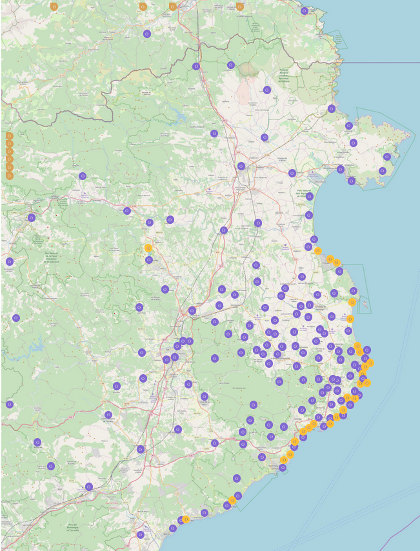 One of the joys of the Costa Brava is the variety of landscapes and we like to visit places and walk (a lot), particularly into and around the Gavarres. Sometimes we travel around on bike. In the summer, we swim and canoe.
One of the joys of the Costa Brava is the variety of landscapes and we like to visit places and walk (a lot), particularly into and around the Gavarres. Sometimes we travel around on bike. In the summer, we swim and canoe.
These then are write ups of walks, hikes and activities that we've done since November 2012, with photos straight from the original walk or activity.
We like to make circular walks and our walks range in length from about 4km (an hour) to around 16km (four hours) - but probably about 2 1/2 hours on average - though if you want to reduce the length, there are usually shortcuts.
To find walks by location, click on the map, which goes to a full sized map with links to individual walks and visits. To our surprise, we were listed in the Sunday Times' Essential Costa Brava (Feb 2017).
The most visited walks are:
- Calella de Palafrugell/Cap Roig to Castell - classic wild Costa Brava
- Far de Sant Sebastia (Llafranc) to Tamariu
- Platja d'Aro and S'Agaro
- Sa Tuna, Cap de Begur, Begur
- Eulogy to the Ruta del Tren Petit (Palafrugell, Palamos, Mont-ras and Vall-llobrega)
- Fornells and Aiguablava walk (GR92)
- Mont-ras to Calella de Palafrugell and Llafranc
- Platja de Castell and La Fosca
- St Antoni de Calonge, Torre Valentina to Platja d'Aro (almost)
- Escala, St Marti d'Empuries and beyond
- Bell-lloc and Castell de Vila-Roma (Palamos)
- Platja Sant Pol to Sant Feliu de Guixols
- Roses - Canyelles beaches to Cap Falconera
- Blanes, Lloret de Mar, Tossa de Mar by GR92
Escala, St Marti d'Empuries and beyond
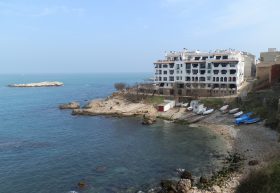 L'Escala is one of the major towns on the Costa Brava and is famed for its anchovies. It is also the location of Empuries, a large ancient Roman town with Greek origins that sits just outside L'Escala. The town is sort of into two parts - the original fishing town/village which is to the north and the more modern estates of Riells that cluster around the southern beach of Riells and run down to Montgo. The two blend into to one another but there is a strongly different character between the more holiday focused modern town and the more work focused old town centre.
L'Escala is one of the major towns on the Costa Brava and is famed for its anchovies. It is also the location of Empuries, a large ancient Roman town with Greek origins that sits just outside L'Escala. The town is sort of into two parts - the original fishing town/village which is to the north and the more modern estates of Riells that cluster around the southern beach of Riells and run down to Montgo. The two blend into to one another but there is a strongly different character between the more holiday focused modern town and the more work focused old town centre.
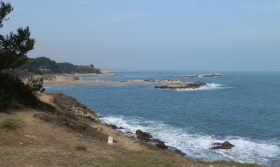 For this walk we started at the fringes of L'Escala old town as we really wanted to go north past the Empuries archeological site, on to St Marti d'Empuries and then onwards along the coast. The path is made for a Sunday stroll with tarmac underfoot and paths across and around the dunes on purpose-made wooden paths. This strollers path runs all the way to St Marti and is perfect if you have a pushchair or are just looking for a passeo.
For this walk we started at the fringes of L'Escala old town as we really wanted to go north past the Empuries archeological site, on to St Marti d'Empuries and then onwards along the coast. The path is made for a Sunday stroll with tarmac underfoot and paths across and around the dunes on purpose-made wooden paths. This strollers path runs all the way to St Marti and is perfect if you have a pushchair or are just looking for a passeo.
 As mentioned we started at the the outskirts of the town and the path follows the coast past low rocky cliffs and then around to the four or five small sandy bays that lay nestled under the dunes, with rocky outcrops reaching out into the sea. We walk past the Hostal d'Empuries hotel and restaurant where it can be pleasant just to while away the time watching the sea and the passersby.
As mentioned we started at the the outskirts of the town and the path follows the coast past low rocky cliffs and then around to the four or five small sandy bays that lay nestled under the dunes, with rocky outcrops reaching out into the sea. We walk past the Hostal d'Empuries hotel and restaurant where it can be pleasant just to while away the time watching the sea and the passersby.
Immediately after the Hotel is Empuries. Founded by the Phoenicians and then extended by the Greeks and Romans, you can see the layout of the Roman town from the path as you pass, but to visit properly you have to go inside to the museum. You can tell from the outside that the town was very large, but in fact the part you can see from the beach path is only about one third of the entire site.
Empuries was a very important trading town and would have been comparable size and importance to Tarragona and Barcelona during the Roman period. The word Emporium for a large shop shares the same route as Empuries, and ancient writers mention the city and its contribution to the Punic Wars, giving some idea of the importance of the city to the Roman Empire. After the Romans left, Empuries remained the chief town in Emporda and was the seat of the counts d'Empuries until the 10th Century, at which point raids by Vikings(!) and muslim navy led to the town being abandoned in favour of Castello d'Empuries to the north.
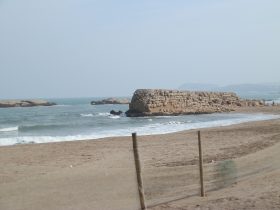 Just after last houses of Empuries, if you look to the sea you'll see the remains of the ancient Greek/Roman port wall standing on the beach. Originally, Empuries would have had a very impressive harbour. The position of the walls relative to the sea level also show how changing coast lines have directly affected the history. At one point Empuries and Sant Marti were on an island surrounded by water. But drainage, sedimentation and changing sea levels now mean the surrounding area is fertile farmland.
Just after last houses of Empuries, if you look to the sea you'll see the remains of the ancient Greek/Roman port wall standing on the beach. Originally, Empuries would have had a very impressive harbour. The position of the walls relative to the sea level also show how changing coast lines have directly affected the history. At one point Empuries and Sant Marti were on an island surrounded by water. But drainage, sedimentation and changing sea levels now mean the surrounding area is fertile farmland.
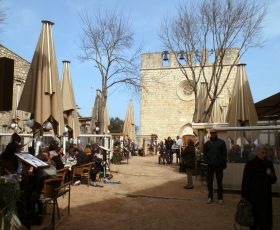 After the port, the path continues up to St Marti d'Empuries, a small walled Catalan village. We walk up into the village to see the church and around the old houses, and even in early March it's teeming with people visiting the restaurants. Behind the restaurants, you pass the remaining walls of the town. Being on the sea, Sant Marti would have been at risk of attacks from pirates. From there we head out towards the long broad beach that extends all the way along to Roses about 20km to the North, taking in the path we walked by the Aiguamolls and still going round.
After the port, the path continues up to St Marti d'Empuries, a small walled Catalan village. We walk up into the village to see the church and around the old houses, and even in early March it's teeming with people visiting the restaurants. Behind the restaurants, you pass the remaining walls of the town. Being on the sea, Sant Marti would have been at risk of attacks from pirates. From there we head out towards the long broad beach that extends all the way along to Roses about 20km to the North, taking in the path we walked by the Aiguamolls and still going round.
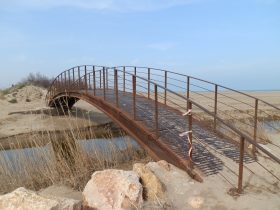 To reach the main beach you have to cross a metal bridge over the river. We walked along the beach watching the campsites to our left. There are two very large campsites that run along the beach. The first is the Balena Allegre (Happy Whale), and the second Les Dunes. In the summer they would be full with people, but out of season we're almost the only people on the beach. Just a handful of long-distance walkers making the hike down to L'Escala walk past.
To reach the main beach you have to cross a metal bridge over the river. We walked along the beach watching the campsites to our left. There are two very large campsites that run along the beach. The first is the Balena Allegre (Happy Whale), and the second Les Dunes. In the summer they would be full with people, but out of season we're almost the only people on the beach. Just a handful of long-distance walkers making the hike down to L'Escala walk past.
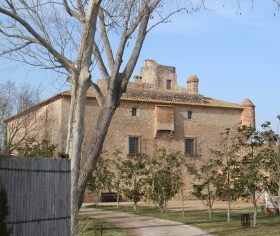 The only problem though is the size of the campsites. On the map there's a break point between the two campsites, otherwise you're hemmed in all the way almost to Sant Pere Pescador. The challenge from the sand is working out where Balena Allegre ends and Les Dunes begins. Fortunately we find the right spot. As you're walking there's a big blue building labelled as the Discoteque Fata Morgana (a Fata Morgana is a mirage). The path runs from the beach up by the side of the disco and from here we're out onto a small narrow road. There's a path behind the crash barriers that's used by cycling campers in the summer. We walk north, hoping to find a way to link to the GR92. There's a path marked on the map that reaches down towards the road. Unfortunately, to reach the path you have to cross a broad stream and there's no bridge link.
The only problem though is the size of the campsites. On the map there's a break point between the two campsites, otherwise you're hemmed in all the way almost to Sant Pere Pescador. The challenge from the sand is working out where Balena Allegre ends and Les Dunes begins. Fortunately we find the right spot. As you're walking there's a big blue building labelled as the Discoteque Fata Morgana (a Fata Morgana is a mirage). The path runs from the beach up by the side of the disco and from here we're out onto a small narrow road. There's a path behind the crash barriers that's used by cycling campers in the summer. We walk north, hoping to find a way to link to the GR92. There's a path marked on the map that reaches down towards the road. Unfortunately, to reach the path you have to cross a broad stream and there's no bridge link.
The only place to reach the GR92 is to go further north past the fields of espaliered fruit trees. The only problem is the path runs out and you have to follow the road which is precariously narrow with little space to pass pedestrians. Fortunately it was quiet and we walked on to reach a left hand turn past the big house of Cortal Gran.
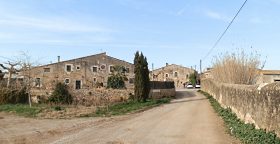 From this point the walk is very very flat and relatively long, through the fields and past more fruit-trees with relatively little variation. After a couple of kilometres the path finally arrives at Cinclaus - a small nest of masias with a chapel built at the site of a former castle, which itself was built on the site of a former Roman villa. Like many old masias, one has been converted into a restaurant and families are just leaving after their Sunday lunch. Cinclaus is also the point where the GR1 path from Finistere in Galicia meets the GR92 long distance coast path.
From this point the walk is very very flat and relatively long, through the fields and past more fruit-trees with relatively little variation. After a couple of kilometres the path finally arrives at Cinclaus - a small nest of masias with a chapel built at the site of a former castle, which itself was built on the site of a former Roman villa. Like many old masias, one has been converted into a restaurant and families are just leaving after their Sunday lunch. Cinclaus is also the point where the GR1 path from Finistere in Galicia meets the GR92 long distance coast path.
We walk back to L'Escala past the riding centre and up, off the road and past a farm. From the crest of the hill we realise that we are right next door to the ancient walls of Empuries - not the part we walked past on the seaward side, but a different part of the town. The walls are 3-4m high and several hundred metres in length. We can just make out the ampitheatre built outside the walls. We follow the path down and walk past the entrance to the Empuries Museum/Archaelogical site, then back along the beach to L'Escala.
Visit: Empuries Greek and Roman remains
Neighbouring walks: L'Escala Riells to sea cliffs and viewpoint of Montgo - Aiguamolls d'Emporda (Empuriabrava) - L'Estartit to Cala Pedrosa and Cala Ferriol - Bellcaire d'Emporda, Tor and Albons - Castello d'Empuries - Sant Pere Pescador river Fluvia - Sobrestany, Montgri and Bellcaire d'Emporda

Cruilles, Monells and Sant Sadurni de l'Heura
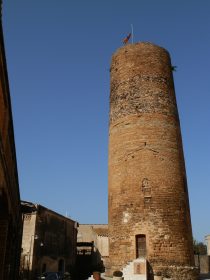 In the early Medieval period La Bisbal was important because it was the seat of the Prince-Bishops of Girona and the area and villages around, rather than being under the control of the Count of Empuries (Comte d'Empuries), were directly under the control of the bishops. As such a number of the bishops had names associated with the local villages (de Monells or de Cruilles). One of the most important of these was Berenguer de Cruilles - the bishop of Girona in 1349 and the first president of the Generalitat de Catalunya - the government of Catalunya - in 1359. People named de Cruilles occur numerous times in Catalan history including important participants in the conquest of Mallorca by the Catalans and as inquisitor general for Spain.
In the early Medieval period La Bisbal was important because it was the seat of the Prince-Bishops of Girona and the area and villages around, rather than being under the control of the Count of Empuries (Comte d'Empuries), were directly under the control of the bishops. As such a number of the bishops had names associated with the local villages (de Monells or de Cruilles). One of the most important of these was Berenguer de Cruilles - the bishop of Girona in 1349 and the first president of the Generalitat de Catalunya - the government of Catalunya - in 1359. People named de Cruilles occur numerous times in Catalan history including important participants in the conquest of Mallorca by the Catalans and as inquisitor general for Spain.
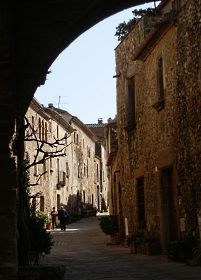 The town of Cruilles now is another pretty, stone-built Catalan village with a large tower in the centre. It's not so large and easy to walk around, though with the exception of the tower and church it's mainly smaller houses so it's not as illustrious as its forebears names would suggest. On this visit, the church tower was under cover behind scaffolding. However, a short walk away is St Miquel de Cruilles, an early Romanesque monastery. We come back this way on the walk.
The town of Cruilles now is another pretty, stone-built Catalan village with a large tower in the centre. It's not so large and easy to walk around, though with the exception of the tower and church it's mainly smaller houses so it's not as illustrious as its forebears names would suggest. On this visit, the church tower was under cover behind scaffolding. However, a short walk away is St Miquel de Cruilles, an early Romanesque monastery. We come back this way on the walk.
From Cruilles we head out towards Monells. As far as we can see on the map, the only option is to follow a road that links the villages. We tried to make a diversion up the hill then navigate a couple of dotted line tracks, but got stuck and ended up having to walk by the edge of fields to get back to the road, so it's probably best to stick to the road.
 Monells we have mentioned before in the walk up to Montnegre. The village from the road doesn't look very interesting, but the centre hides arched arcades and stone gates. We walk down one of the old streets to the gate at the bottom to see the stream, before going back under the arches and into the inner court yard where people are eating under the arches.
Monells we have mentioned before in the walk up to Montnegre. The village from the road doesn't look very interesting, but the centre hides arched arcades and stone gates. We walk down one of the old streets to the gate at the bottom to see the stream, before going back under the arches and into the inner court yard where people are eating under the arches.
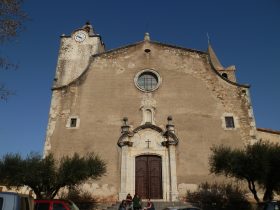 We follow the path out along the stream (similar to the other Monells walk), but take a left hand road past a small cluster of farm buildings. This takes us towards Sant Sadurni de l'Heura, the third of the towns on the route. Sant Sadurni has an impressive 18th century church, and is the chief village of the poblacio made up of the three villages, but compared to both Cruilles and Monells feels a little more run down with fewer hidden streets to explore.
We follow the path out along the stream (similar to the other Monells walk), but take a left hand road past a small cluster of farm buildings. This takes us towards Sant Sadurni de l'Heura, the third of the towns on the route. Sant Sadurni has an impressive 18th century church, and is the chief village of the poblacio made up of the three villages, but compared to both Cruilles and Monells feels a little more run down with fewer hidden streets to explore.
We leave the village and cross the main car road, going past two or three restaurants. The car-parks are full with locals out for lunch. We continue on the track indicated to Cruilles, passing the small chapel of Sant Joan de Salelles (named after Saint John the Baptist - Joan is Catalan for John, a boy's name). As we pass a large masia we reach a crossroads and the flat fields spread out in front of us, framed by the Gavarres hills in the background with views to La Bisbal.
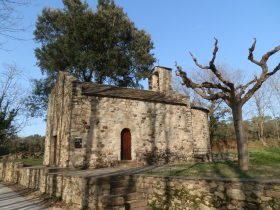 Along the track we turn up to the left to visit Sant Miquel de Cruilles. The monestary is famous for being one of the early Romanesque buildings (Romanesque is known as Norman architecture in England). Built in 904, the style is quite muscular and plain, but is characteristic of many older buildings in Catalona and is a style that almost emerged from this part of the world. It was superceded by the Gothic style - much more pointed arches. Sant Miquel itself is a small hamlet of 10-15 renovated buildings. The path then runs down the hill, past the pig farm (which sort of ruins the view of Cruilles) and back to the car.
Along the track we turn up to the left to visit Sant Miquel de Cruilles. The monestary is famous for being one of the early Romanesque buildings (Romanesque is known as Norman architecture in England). Built in 904, the style is quite muscular and plain, but is characteristic of many older buildings in Catalona and is a style that almost emerged from this part of the world. It was superceded by the Gothic style - much more pointed arches. Sant Miquel itself is a small hamlet of 10-15 renovated buildings. The path then runs down the hill, past the pig farm (which sort of ruins the view of Cruilles) and back to the car.
Neighbouring walks: Monells and Mont-negre - Corça, Casavells, Matajudaica - La Bisbal, Vulpellac, Castell d'Emporda, Fonteta - St Pol de Bisbal and Santa Lucia - Mont-ras to Fitor and on to Fonteta and Vulpellac - Madremanya, Els Angels, Sant Marti Vell - Canapost, Poblet Iberic and Ullastret - Cruilles and masias and streams
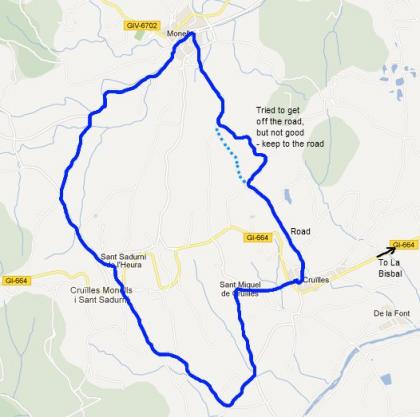
Bell-lloc and Castell de Vila-Roma (Palamos)
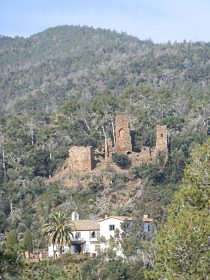 In the walk from Calonge into the Gavarres, the aim had been to reach the Castle of Vila-Roma just to the north of Palamos. The castle itself is long since ruined, but beneath the castle is the old convent of Bell-loc which has now been converted into a private residence, hotel and vineyard.
In the walk from Calonge into the Gavarres, the aim had been to reach the Castle of Vila-Roma just to the north of Palamos. The castle itself is long since ruined, but beneath the castle is the old convent of Bell-loc which has now been converted into a private residence, hotel and vineyard.
This is a walk we've done several times before, but we like to do it in spring when the ground isn't so dry and the flowers and wild asparagus are starting to appear in the woods.
The castle itself sits above a stream and looks down the valley to St Joan de Palamos. You can see it from the dual carriageway if you know where to look, but it's very easy to miss the rust-coloured stone in among the trees if you're just passing for the first time.
To reach the castle it would be an easy walk from either La Fosca or Palamos itself - there is a footpath under the new dual carriageway by the La Fosca junction up into the Vila-Roma area.
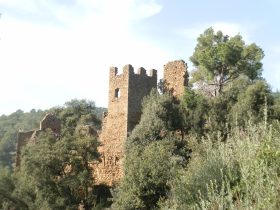 Instead, we start a little closer and park just outside the Hutchinson factory which is a little incongrous to see the factory in among the fields (the company is French and makes advanced materials for things like pipes and seals and clutches among other things).
Instead, we start a little closer and park just outside the Hutchinson factory which is a little incongrous to see the factory in among the fields (the company is French and makes advanced materials for things like pipes and seals and clutches among other things).
Walk along the lane past the picnic area and take the signposted path to the left and into the woods. The road forks a little way along and we take the right fork (we come back down the left side). The path climbs into the woods and curls around the valley side to give the first view of the castle.
The castle itself only has about one and a half tower-bits standing, so it's quite decrepit, but it looks like a proper ruined castle, albeit on the small side.
Below the castle is a white building and vineyards. This is the old convent of Bell-loc which we will pass on the way back.
There would have been castles and towers along all the eastern edges of the Gavarres in medieval times. To the south is Castell d'Aro. On the coast is Torre Valentino. Palamos itself was a royal garrison port, but before this had the castle of Sant Esteve at La Fosca. Mont-ras had a watch-out tower and there was a castle at Sant Susanna de Peralt and obviously the castle at Begur.
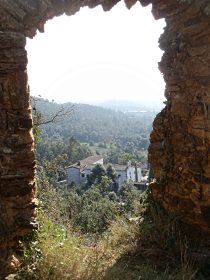 The path continues right to the edge of the castle itself. It's relatively overgrown inside with masonery on the floor, but with some arches and windows still standing.
The path continues right to the edge of the castle itself. It's relatively overgrown inside with masonery on the floor, but with some arches and windows still standing.
The castle is open to explore (update: signs say keep out now) and gives views down the valley and out to sea.
On the far side from the footpath, the castle stands on a bluff above the stream below (a sharp drop so watch if you're with small children).
Having explored and taken a few photos we continue along the track. A signpost points to the dolmen to the right, but we continue. There are two paths from the castle both marked with poles topped with yellow in an attempt to stop mountain bikes.
We take the upper path which is now a narrow track into the woods above the stream to the left.
At the first left junction we turn down the valley. A sudden burst of noise and screeching brakes as a coven of mountain bikers come heading down the path. The tracks very small and bumpy but they some how manage to get their bikes down the tracks and pass with a 'Bon Dia' salutation.
At the bottom is a small stream, swollen by the recent rain and we have to skip across the stepping stones to get to the other side. Then we follow the stream down through what seems like a wide river bottom littered with branches and bits of old trees as if it's a valley that gets sudden torrents of water rushing through it at times of peak rain.
Underneath the castle, the path turns up and out to Bell-loc convent now hotel and vineyard. The signs outside say there is a small chapel and the people of Palamos used to come up to the convent once a year for a festival. Now it's a simple walk along the lane by the stream and past the vineyards. We see the path up to Calonge we would have arrived at if we'd continued the other walk.
Finally we return to the fork and back past the farmhouses and picnic area and back to the car.
Update (June 2014): The Fire on the Costa Brava in March that we reported affected most of the area around Bell.lloc and Castell de Vila Roma with much of the woods burnt by the fire.
What's remarkable is that walking in June while many trees are still black from the fire, vegetation is returning and the fire-resistent cork trees are showing foliage from behind the black-burnt bark. With much of the undergrowth and scrub having been burnt away and trees still recovering, the area is much more open with big vistas out towards the sea, particularly if you go up from the Castle to the Dolmen on top of the hill (Montagut).
What's more remarkable is that in clearing the ground, the fire has revealed a hidden history.
In the woods to the back of the castle, it's possible to see man-made terrace walls and the outlines of buildings that would have been in what is now forest suggesting that in the past the valley might not have been wooded to the extent it is now.
Neighbouring walks: La Fosca to Palamos - Calonge into the Gavarres - Mont-ras 'boar' walk - Platja de Castell and La Fosca - Calella de Palafrugell/Cap Roig to Castell - classic wild Costa Brava - Eulogy to the Ruta del Tren Petit (Palafrugell, Palamos, Mont-ras and Vall-llobrega) - Mont-ras to Fitor and on to Fonteta and Vulpellac
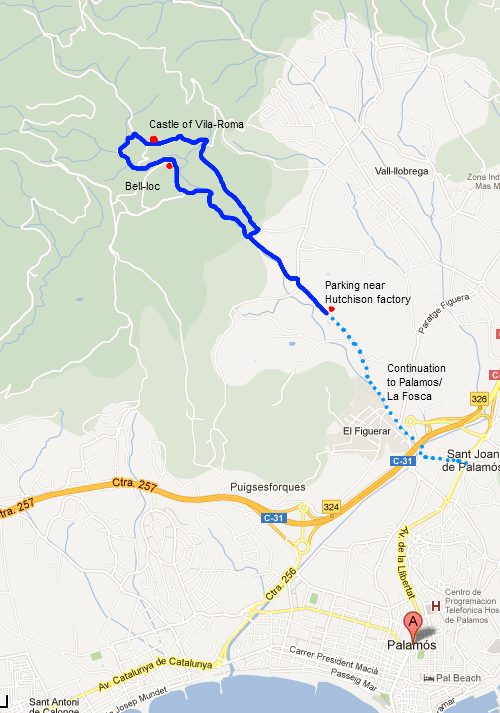
Vilopriu and Valldavia
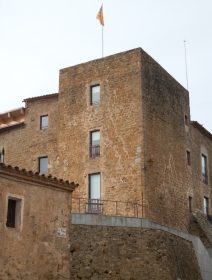 February is the month most likely to see snow. It also marks the first signs of Spring with the first blossoms in the almond orchards, and meadow flowers starting to appear in the fields. In past years the snow has reached right down to the coast and in one year it combined with a strong wind and took down electricity pylons leaving a few towns without electricity for a few days. Having said that, snow is normally so fleeting and unusual by the coast that it is greeted by an almost childish enthusiasm and excitement.
February is the month most likely to see snow. It also marks the first signs of Spring with the first blossoms in the almond orchards, and meadow flowers starting to appear in the fields. In past years the snow has reached right down to the coast and in one year it combined with a strong wind and took down electricity pylons leaving a few towns without electricity for a few days. Having said that, snow is normally so fleeting and unusual by the coast that it is greeted by an almost childish enthusiasm and excitement.
The weekend of this walk was the one the forecasters estimated as being the most likely to have snow. We were looking forward to it and then the day turned out to be just hung with overcast cloud. Which meant that for the walk, the views and landscape tended to disappear into the haze, which obviously doens't make for great photos.
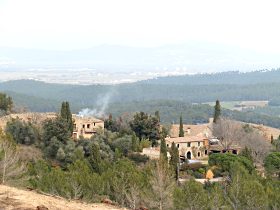 Vilopriu is a small village off the beaten track in the hills between L'Escala and its motorway junction at Orriols. It's an area we'd not visited before as the roads skirt around the hills, either to Colomers to the south - which is where you can hire canoes to meander down the river Ter to Verges, or past Camallera to Viladamat to the North. The village itself is small but perfectly preserved. There are no vilas or urbanisations nearby just the old stone houses of the village that have been restored. We parked just under the castle in the 'main' square. The castle itself is not the ajuntament building and there is even a lift access for wheelchairs to get to the main level of the castle where there are views across the fields and out to the Gaverres in the far distance.
Vilopriu is a small village off the beaten track in the hills between L'Escala and its motorway junction at Orriols. It's an area we'd not visited before as the roads skirt around the hills, either to Colomers to the south - which is where you can hire canoes to meander down the river Ter to Verges, or past Camallera to Viladamat to the North. The village itself is small but perfectly preserved. There are no vilas or urbanisations nearby just the old stone houses of the village that have been restored. We parked just under the castle in the 'main' square. The castle itself is not the ajuntament building and there is even a lift access for wheelchairs to get to the main level of the castle where there are views across the fields and out to the Gaverres in the far distance.
The walk starts to the west of the village and we had to go around the bottom of the castle to find the start of the track as it runs past a farmyard. The track is broad and easy to follow out towards the woods and fields around the village. It's a rolling countryside, with meadows adjoining small copses and has a feel of a walk in the UK or even Germany or France. It's a very big contrast to the much more Mediterranean walk of Espolla. We follow the path through the woods. It reaches a tarmac road and we turn left down into the hamlet of Les Pins - little more than 2-3 old masias and a chapel, but it seems that almost every other field has horses. At this point, the walk picks up the GR1. This is the first time we've been on this route. The GR (Grand Radonnee in French, Gran Recorrido in Spanish) are a network of long distance paths in Europe. The GR92 coastal path is the one we are most familiar. The GR1 runs from Finisterre at the most western point of Spain in Galicia across the country to Empuries.
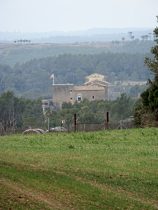 The GR1 takes us on a gentle incline up the hill past ploughed fields and with hazy views into the distance. As we reach the top a radio mast appears and we make a right hand turn. At this point going onwards would take you down into Valldavia. There's a castle marked on the map, but while we saw what looked like masia's we didn't really see a castle as such. It could have been than we needed to go down to the village to find it. From the area round the radio mast there are views out across St Pere Pescador and on towards Roses, but it was too hazy to make for a good photo. The area around the mast had obviously been subject to a forest fire and all the trees had been cleared. Summers are normally very dry, and the slightest flame can set of a rapidly spreading wild fire. Last summer, a wild fire that started with the borders of France spread over 40km almost to Figueres and was visible from Begur. The smoke reaching down even as far as Barcelona, so there are very strong prohibitions on fires in the woods and forests during the summer months. However, having had the fire, and without the trees, the views were much more extensive than they might have been.
The GR1 takes us on a gentle incline up the hill past ploughed fields and with hazy views into the distance. As we reach the top a radio mast appears and we make a right hand turn. At this point going onwards would take you down into Valldavia. There's a castle marked on the map, but while we saw what looked like masia's we didn't really see a castle as such. It could have been than we needed to go down to the village to find it. From the area round the radio mast there are views out across St Pere Pescador and on towards Roses, but it was too hazy to make for a good photo. The area around the mast had obviously been subject to a forest fire and all the trees had been cleared. Summers are normally very dry, and the slightest flame can set of a rapidly spreading wild fire. Last summer, a wild fire that started with the borders of France spread over 40km almost to Figueres and was visible from Begur. The smoke reaching down even as far as Barcelona, so there are very strong prohibitions on fires in the woods and forests during the summer months. However, having had the fire, and without the trees, the views were much more extensive than they might have been.
We walk down from the viewpoint and out along past the municipal open-air swimming pool. The GR1 takes us to a tarmac road and we cross the road, while the GR1 would head to the left. The path continues through the woods giving a view of Vilopriu through the trees, before we turn back to the village.
Neighbouring walks: Verges, Tallada d'Emporda and Maranya - Colomers and Jafre
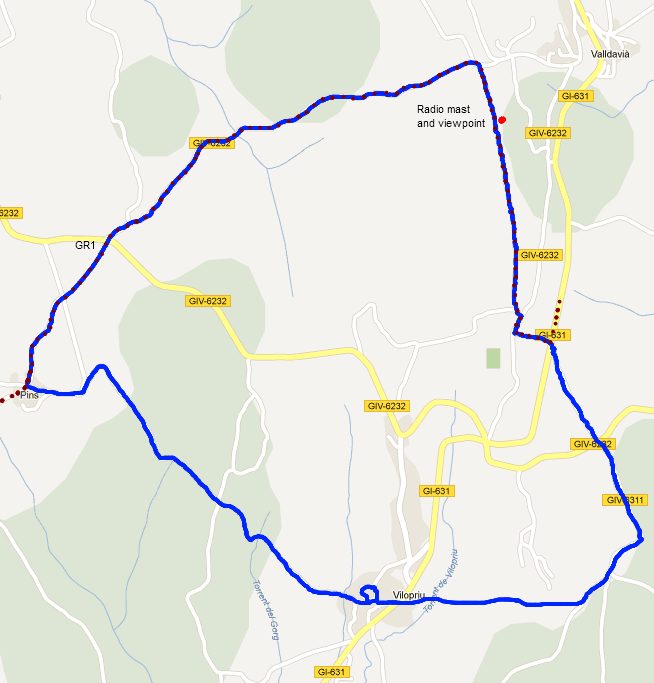
Espolla to Rabos
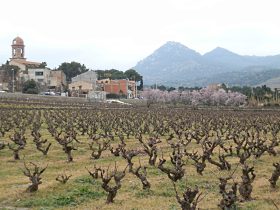 This time we have something different from the green fields, coast and cork hills of the Baix Emporda. Espolla and Rabos are towards the mountains that border France in the Alt Emporda region. As you move northwards off the Empordan plains, the routes into the mountains both at Espolla and out towards Cap de Creus become more barren with sharper stones under foot. The fields give way to vineyards and olive groves built on levelled fields surrounded by dry-stone walls that look as they were built hundreds or thousands of years ago.
This time we have something different from the green fields, coast and cork hills of the Baix Emporda. Espolla and Rabos are towards the mountains that border France in the Alt Emporda region. As you move northwards off the Empordan plains, the routes into the mountains both at Espolla and out towards Cap de Creus become more barren with sharper stones under foot. The fields give way to vineyards and olive groves built on levelled fields surrounded by dry-stone walls that look as they were built hundreds or thousands of years ago.
We headed towards Espolla on a whim after having visited Peralada. Our map at 1:50000 wasn't so great so we really lacked any good walking directions, but the route between Espolla and Rabos seemed as if it would at least give a taste of walking in this area and perhaps provide some experience for planning some other walks up towards the Albera mountains.
Espolla is a small town surrounded by vineyards with a small castle and a prominent church. It's feels far from the tourist track and is more of a regular work-a-day Catalan village. The paths are well marked from the village and there is a route over the mountains to Banyuls sur Mer (Banyuls de la Merenda). The day was quite overcast - February is the month with the greatest chance of snow and days oscillate between warm sun-filled days and chilly evenings presaging the start of spring, and overcast days with threats of rain or sun.
 The path follows a track among the vineyards and olive trees into the hills. It feels quite dry and isolated and there aren't many specific points of interest. The olive groves and vines are well tended though (we discovered later than Espolla olive oil is renowned in Catalonia) and there are shotgun cartridges almost all the way along the path indicating its attraction to hunters - when we got back to Espolla a large group with dogs and 4x4s was preparing to go out. As the path turns over the hill and back down towards Rabos, there are the first glimpses of views down towards the sea and the Emporda plain, though it was too overcast for us to be able to see clearly.
The path follows a track among the vineyards and olive trees into the hills. It feels quite dry and isolated and there aren't many specific points of interest. The olive groves and vines are well tended though (we discovered later than Espolla olive oil is renowned in Catalonia) and there are shotgun cartridges almost all the way along the path indicating its attraction to hunters - when we got back to Espolla a large group with dogs and 4x4s was preparing to go out. As the path turns over the hill and back down towards Rabos, there are the first glimpses of views down towards the sea and the Emporda plain, though it was too overcast for us to be able to see clearly.
The path runs down to Rabos. Rabos is a village built on the slopes that runs down to an old bridge and river. From the bridge, Rabos has some charm with what looks like a church crossed with a castle, with parapets above the nave. There are footpaths and roads towards the monestary of Sant Quirze de Colera
For the walk back to Espolla we followed the road. It wasn't busy, but next time we come up here we really have to have better maps.
Neighbouring walks: Peralada - La Jonquera to Fort de Bellegarde (France) - Port de la Selva - Roses and Roses Ciutadella - Llança - Cadaques and Port Lligat - Port de la Selva - Cadaques to Roses - Sant Pere de Rodes - Waterfall at Les Escaules (Boadella) - Castell de Requesens
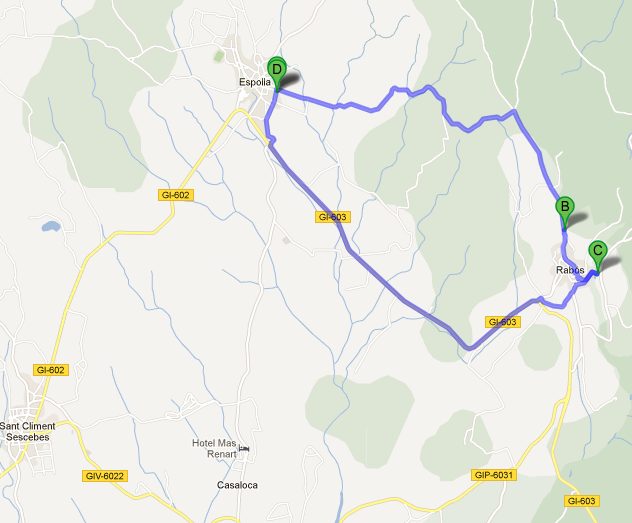
Peralada
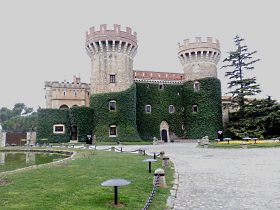 Peralada is a town located to the north-east of Figures just off the road to Llanca. The town is the home to the castle of the counts of Peralada and Rocaberti (Rocaberti is a castle, now in ruins, close to the modern French-Spanish border at La Perthus) and the wines of Peralada, part of the DO Emporda wine appelation.
Peralada is a town located to the north-east of Figures just off the road to Llanca. The town is the home to the castle of the counts of Peralada and Rocaberti (Rocaberti is a castle, now in ruins, close to the modern French-Spanish border at La Perthus) and the wines of Peralada, part of the DO Emporda wine appelation.
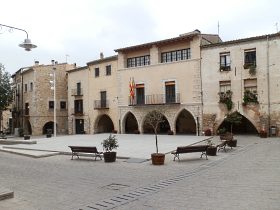 In around 1000 (so close to the time of William the Conqueror in England), Peralada was the capital of Alt Emporda. At this time Catalonia was a collection of counties (literally ruled by counts). The history of Catalonia and its formation and development is bound up with the counts of Catalonia and feudal lines of homage, caught up with marriage and alliances. The count of the County of Barcelona was the dominate county, but this did not stop disputes with counts such as Urgell or Empuries (the count of Peralada was a vassal of the Count of Empuries). Marriage between the Count of Barcelona and the daughter of the King of Aragon, lead to the creation of the Aragon empire which, at its highpoint in the 1300s included Sardinia, Southern Italy and Sicily, and even out to Athens and parts of Greece. A succession dispute led to the crown of Aragon being entwined and then finally joined with kingdom of Castille, to the disadvantage of Catalonia. As Castille rose in importance and promenence though both the discoveries in America (which were only accessible to Castillans), and the joining of the Spanish crowns and the crown of the Holy Roman Empire under Carles V - which gave Spain its Dutch and Milanese territories in Europe, Catalonia became relatively peripheral. The Castillanisation of Spain causing simmering resentment in Catalonia that eventually blew up in the Reapers Wars of the 1640s. The role of counts, their marriages and their disputes and feuds is then a key part of Catalan history.
In around 1000 (so close to the time of William the Conqueror in England), Peralada was the capital of Alt Emporda. At this time Catalonia was a collection of counties (literally ruled by counts). The history of Catalonia and its formation and development is bound up with the counts of Catalonia and feudal lines of homage, caught up with marriage and alliances. The count of the County of Barcelona was the dominate county, but this did not stop disputes with counts such as Urgell or Empuries (the count of Peralada was a vassal of the Count of Empuries). Marriage between the Count of Barcelona and the daughter of the King of Aragon, lead to the creation of the Aragon empire which, at its highpoint in the 1300s included Sardinia, Southern Italy and Sicily, and even out to Athens and parts of Greece. A succession dispute led to the crown of Aragon being entwined and then finally joined with kingdom of Castille, to the disadvantage of Catalonia. As Castille rose in importance and promenence though both the discoveries in America (which were only accessible to Castillans), and the joining of the Spanish crowns and the crown of the Holy Roman Empire under Carles V - which gave Spain its Dutch and Milanese territories in Europe, Catalonia became relatively peripheral. The Castillanisation of Spain causing simmering resentment in Catalonia that eventually blew up in the Reapers Wars of the 1640s. The role of counts, their marriages and their disputes and feuds is then a key part of Catalan history.
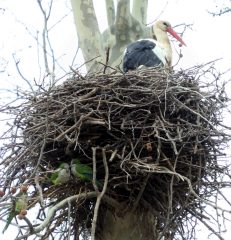 Modern Peralada has the, still privately-owned, castle of Peralada still in the possession of the original family. The current castle is was built in the 19th century on the site of the original 9th century castle in a French Chateau-style so compared to most of the Catalan castles we see which retain their medieval origins, this one is quite refined. In keeping with the Chateau style the castle has grounds and gardens. We had hoped to be able to visit, but these were closed to the public. In the summer, the castle has a museum that is open to the public, and also has a number of music festivals. The best we could do was to visit the courtyard, just off from the casino entrance - the casino is open all year around, at least to get a glimpse of the castle.
Modern Peralada has the, still privately-owned, castle of Peralada still in the possession of the original family. The current castle is was built in the 19th century on the site of the original 9th century castle in a French Chateau-style so compared to most of the Catalan castles we see which retain their medieval origins, this one is quite refined. In keeping with the Chateau style the castle has grounds and gardens. We had hoped to be able to visit, but these were closed to the public. In the summer, the castle has a museum that is open to the public, and also has a number of music festivals. The best we could do was to visit the courtyard, just off from the casino entrance - the casino is open all year around, at least to get a glimpse of the castle.
The town itself is just behind the castle and has its own town walls. It is a typically Catalan town with a church on the high point, and a network of squares and small streets through the centre. The town museum has the well preserved remains of a cloister from an abbey that was in the town - you can just get a glimpse from the back streets. Unfortunately being Sunday much of the town was closed so we couldn't explore much further which meant that we just did a lap of the town. Though we did get the remarkable site of parrots sheltering under stork nests as the storks used their beaks as castanets to chatter to each other.
Originally we had planned on walking direct from Peralada, but the only map we had was a 1:50,000 which doesn't give very good walking resolution and the marked paths seemed to be walks of 6-7km with no obvious circular-route back. So instead we decided to go on into the hills.
Neighbouring walks: Espolla to Rabos - La Jonquera to Fort de Bellegarde (France) - Port de la Selva - Roses and Roses Ciutadella - Llança - Cadaques and Port Lligat - Port de la Selva - Cadaques to Roses - Castello d'Empuries - Llança - Castell de Requesens
City visit: Figueres and Castell de Sant Ferran
Palau-sator and Peratallada
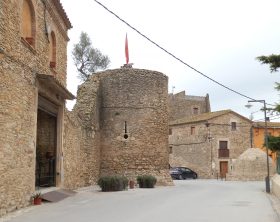 Palau-sator and Peratallada are small very picturesque medieval towns/villages situated just outside Pals (which is itself very picturesque). Of the two, Peratallada is the prettiest and for me, is actually prettier than Pals, though because it sits in a shallow valley, it lacks the prominence of Pals village. Peratallada (which I believe means cut stone - pedra tallada) has a moat around one side literally cut into rock, and walls and gates surrounding a maze of cobblestone streets and golden stoned houses. Palau-sator is smaller and less refined and has rings of houses around the central castle/tower.
Palau-sator and Peratallada are small very picturesque medieval towns/villages situated just outside Pals (which is itself very picturesque). Of the two, Peratallada is the prettiest and for me, is actually prettier than Pals, though because it sits in a shallow valley, it lacks the prominence of Pals village. Peratallada (which I believe means cut stone - pedra tallada) has a moat around one side literally cut into rock, and walls and gates surrounding a maze of cobblestone streets and golden stoned houses. Palau-sator is smaller and less refined and has rings of houses around the central castle/tower.
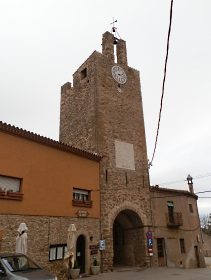 A feature of the two villages, and a number of other rural villages and masias (farmhouses) is the number of restaurants. Both villages, though small, have a disproportionate number of restaurants in the villages. Though tourists use them, in reality, unlike the coastal resorts which are mostly geared towards the influx of foreign holidaymakers, these restaurants are much more local and authentic. And so on a weekend at lunchtime they tend to fill up with Catalans out for lunch.
A feature of the two villages, and a number of other rural villages and masias (farmhouses) is the number of restaurants. Both villages, though small, have a disproportionate number of restaurants in the villages. Though tourists use them, in reality, unlike the coastal resorts which are mostly geared towards the influx of foreign holidaymakers, these restaurants are much more local and authentic. And so on a weekend at lunchtime they tend to fill up with Catalans out for lunch.
We sometimes hear of people looking at holidays on the Costa Brava who worry about coming out of season in case places will be shut. Well yes, some places in the coastal resorts do close through the winter months, particularly the more tourism-focused places. The better restaurants and bars that can and do attract a more local and year-round clientele tend to stay open. And in practice you find many more of these inland than you do at the coast.
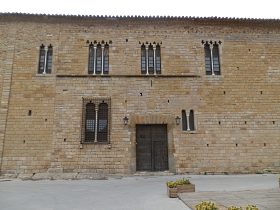 However, to appreciate and get to the restaurants you have to be appreciative of the Catalan hours and eating habits. Broadly speaking, people in Spain do not eat in the early evening and in particular, around the Costa Brava, locals will tend to have their main meal during the middle of the day and will take their time over the meal - so say start at 2pm and finish some time at or after 4pm (the Catalans have the same breakfast-dinner-tea-supper pattern as Northern England - alternatively imagine every day is like Sunday or Christmas dinner, eaten in the middle of the day). If they go out again it will be after 9pm and often only at the weekends.
However, to appreciate and get to the restaurants you have to be appreciative of the Catalan hours and eating habits. Broadly speaking, people in Spain do not eat in the early evening and in particular, around the Costa Brava, locals will tend to have their main meal during the middle of the day and will take their time over the meal - so say start at 2pm and finish some time at or after 4pm (the Catalans have the same breakfast-dinner-tea-supper pattern as Northern England - alternatively imagine every day is like Sunday or Christmas dinner, eaten in the middle of the day). If they go out again it will be after 9pm and often only at the weekends.
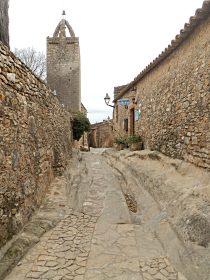 You would think, having been here for a while and having done a reasonable amount of walking, a simple walk like Palau-sator to Peratallada that we've done before on bikes couldn't go wrong. The distance between the two villages is around 2-3 km, so not far The idea was to make a circular walk - the main route would be the GR92, but there's a path past the church outside Peratallada so we should be able to make a loop. We got hamstrung with two problems - firstly we took the wrong map, and secondly we took the wrong turn, so we didn't quite do the walk we wanted and ended up having to track across fields to make the link.
You would think, having been here for a while and having done a reasonable amount of walking, a simple walk like Palau-sator to Peratallada that we've done before on bikes couldn't go wrong. The distance between the two villages is around 2-3 km, so not far The idea was to make a circular walk - the main route would be the GR92, but there's a path past the church outside Peratallada so we should be able to make a loop. We got hamstrung with two problems - firstly we took the wrong map, and secondly we took the wrong turn, so we didn't quite do the walk we wanted and ended up having to track across fields to make the link.
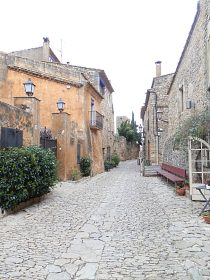 The other thing is, that by our standards, it's actually not that great a walk - the countryside is fairly flat and level and mainly fields, so it's much more of a gentle stroll through the farmland without many points of interest on the way, unless you count the pig farms and the wafting country smell they generate.
The other thing is, that by our standards, it's actually not that great a walk - the countryside is fairly flat and level and mainly fields, so it's much more of a gentle stroll through the farmland without many points of interest on the way, unless you count the pig farms and the wafting country smell they generate.
We started at Palau-sator. Palau means palace, but really refers to a large house or castle in the town (Palafrugell and Palamos have the same Palau root). The restaurants were busy, so parking was haphazard though there was space. We took the time to take in the town including the odd stone igloo well and clock tower. From the village we followed the path towards Ullastret to start with - this is mainly tarmac but quiet. Having bought the wrong map and relying on memory we knew we needed a left-hand turn. Unfortunately we took the turn too early and looped around the village. Which then bought us back to the GR92. This was supposed to be the route back, so instead we took the flat walk down to Peratallada.
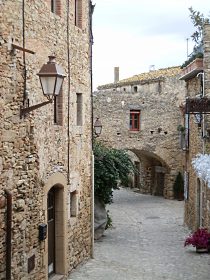 Peratallada is one of the hidden and lesser-known gems we always take relatives too. Often they've heard of Pals, but know nothing about Peratallada. We followed the river to the ford, and then entered into a small square with an arched arcade that represents the main entrance. In summer or when they have craft markets, the town throngs with people. It's then a question of exploring the myriad of narrow streets, archways and bridges over the road and the part where carts have worn tracks into the stone of the road. The exit point it to the north, the roads in the town wind their way to the top and a stone gate. If you go through the gate, you find yourself on a bridge above a moat cut out of the stone. What with the French, pirates and brigands almost all catalan villages had to be able to defend themselves from attack.
Peratallada is one of the hidden and lesser-known gems we always take relatives too. Often they've heard of Pals, but know nothing about Peratallada. We followed the river to the ford, and then entered into a small square with an arched arcade that represents the main entrance. In summer or when they have craft markets, the town throngs with people. It's then a question of exploring the myriad of narrow streets, archways and bridges over the road and the part where carts have worn tracks into the stone of the road. The exit point it to the north, the roads in the town wind their way to the top and a stone gate. If you go through the gate, you find yourself on a bridge above a moat cut out of the stone. What with the French, pirates and brigands almost all catalan villages had to be able to defend themselves from attack.
Leaving the village we head past the church and out to the north. This path is slightly raise with a wood to the left, so has a little more character. Once again though we got lost. We thought we could find a short cut and took a track to the right, only to find ourselves at the edge of a field. Rather than go back we went around the field to link up with the path we came on. If we'd continued on the route would connect to the Gualta, Llabia, Fontanilles walk to the north. Or for another extension, from Peratallade, it connects to the Clots de Sant Julia walk to the south.
Neighbouring walks: La Bisbal, Vulpellac, Castell d'Emporda, Fonteta - Canapost, Poblet Iberic and Ullastret - Clots de Sant Julia (Vulpellac) - Gualta, Llabia, Fontanilles and the lake of Ullastret - Evening walk Pals to Sant Feliu de Boada - Santa Susanna de Peralta and Sant Climent de Peralta - Canapost to the medieval fair at Peratallada
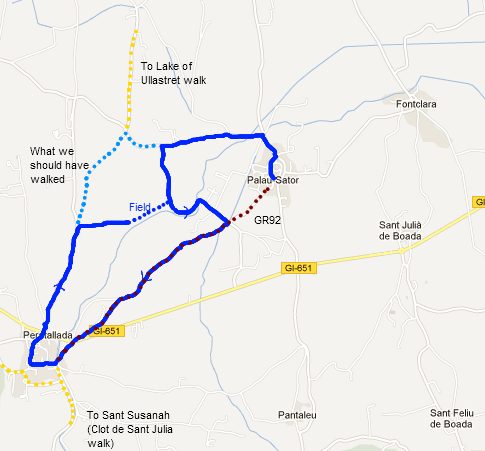
Masos de Pals, Begur, Sa Riera and Platja de Pals
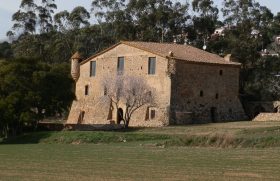 Though Pals and Begur are neighbours near the coast, in driving terms they seem quite distant and a long way apart. The aim of this walk was to link the two. Pals as an area splits into three or four 'subvillages' depending on how you count them. There's the main old town with the tower on the hill. From the historic centre across the bypass and roundabout by the Tourist office is the church and the subvillage of Masos de Pals including the hill of Mas Tomasi, and then separate again down to the sea is the area of Platja de Pals including Pineda de Pals. We've already described the walk to Pals from Regencos via Quermany to Pals. This walk skirts the base of the hills and up to Begur.
Though Pals and Begur are neighbours near the coast, in driving terms they seem quite distant and a long way apart. The aim of this walk was to link the two. Pals as an area splits into three or four 'subvillages' depending on how you count them. There's the main old town with the tower on the hill. From the historic centre across the bypass and roundabout by the Tourist office is the church and the subvillage of Masos de Pals including the hill of Mas Tomasi, and then separate again down to the sea is the area of Platja de Pals including Pineda de Pals. We've already described the walk to Pals from Regencos via Quermany to Pals. This walk skirts the base of the hills and up to Begur.
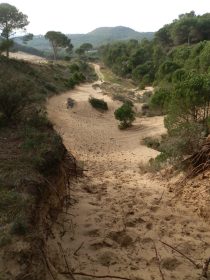 We parked and started at the church in Masos de Pals, then followed the road just below the church past the masias behind Masos de Pals. Eventually the tarmac roadway (it's very quiet) becomes the GR92 and then turns into a dirt track running around the base of the hill of Mas Tomasi. The hill itself seems to be covered by villas straining for a view. The path passes by Sa Gavetes - a rural hotel converted from a masia with a turret on one corner and into the woods. As we've mentioned elsewhere (eg the walk from Sobrestany), while the southern side of the hills can be quite stony, close to the coast, the northern side is often very sandy. And in fact the whole of the walk through the woods is like climbing one enormous sand dune that has been covered with pines. As the path climbs, the sand underfoot seems to become softer and it's almost like walking on a soft beach - which makes the walking heavy footed. The path takes you past sand quarries and you can see the depth of sand that makes up the dune. In the woods we see a few people out with long poles aiming to collect pinecones for pinenuts, and in many areas there are signs saying warning people not to collect them, as many of the woods are private though without physical separation between the plots of land (no building is allowed) and a general freedom to roam.
We parked and started at the church in Masos de Pals, then followed the road just below the church past the masias behind Masos de Pals. Eventually the tarmac roadway (it's very quiet) becomes the GR92 and then turns into a dirt track running around the base of the hill of Mas Tomasi. The hill itself seems to be covered by villas straining for a view. The path passes by Sa Gavetes - a rural hotel converted from a masia with a turret on one corner and into the woods. As we've mentioned elsewhere (eg the walk from Sobrestany), while the southern side of the hills can be quite stony, close to the coast, the northern side is often very sandy. And in fact the whole of the walk through the woods is like climbing one enormous sand dune that has been covered with pines. As the path climbs, the sand underfoot seems to become softer and it's almost like walking on a soft beach - which makes the walking heavy footed. The path takes you past sand quarries and you can see the depth of sand that makes up the dune. In the woods we see a few people out with long poles aiming to collect pinecones for pinenuts, and in many areas there are signs saying warning people not to collect them, as many of the woods are private though without physical separation between the plots of land (no building is allowed) and a general freedom to roam.
 We also notice lots of horse tracks and as we climb back towards civilisation from the woods we pass Hipica Begur, a large riding centre. Horse riding is popular in the Costa Brava and would make an alternative to walking for those who ride. The path then runs up into the outskirts of Begur.
We also notice lots of horse tracks and as we climb back towards civilisation from the woods we pass Hipica Begur, a large riding centre. Horse riding is popular in the Costa Brava and would make an alternative to walking for those who ride. The path then runs up into the outskirts of Begur.
Begur itself is a district as well as a town. The historic town sits on a hill under a ruined castle and has views all around. The town itself has a main street with many 'Indianer' houses - these are houses built by returning Catalan families who had made their fortunes in Cuba. Around Begur are a range of other villages and beaches and there is a connecting walk joining the various coves and bays from Sa Tuna to Aiguafreda around to Sa Riera. We'll redo that walk sometime later in the year.
 This time we wanted to follow the path down to Sa Riera. The first times we walked this we followed the road down which isn't very pleasant to walk. Last time we discovered a path down by a stream halfway down the road. So this time we're looking for the start of the path as it's not marked on our maps. So instead of going into Begur, we follow a green-white path into the Parc d'Arbreda - a park under a raised building built in rust-coloured oxidised steel. The park has a range of play areas, and to begin with I missed the signpost, but the path sort of skips out off the edge of the park and down.
This time we wanted to follow the path down to Sa Riera. The first times we walked this we followed the road down which isn't very pleasant to walk. Last time we discovered a path down by a stream halfway down the road. So this time we're looking for the start of the path as it's not marked on our maps. So instead of going into Begur, we follow a green-white path into the Parc d'Arbreda - a park under a raised building built in rust-coloured oxidised steel. The park has a range of play areas, and to begin with I missed the signpost, but the path sort of skips out off the edge of the park and down.
We follow the stream down the valley. To start with the stream is dry, but as you go down water starts to flow and soon there are pools and waterfalls and even a semi-gorge through the rocks. Towards the bottom the path almost seems to pass through someone's garden before popping out among the buildings of Sa Riera.
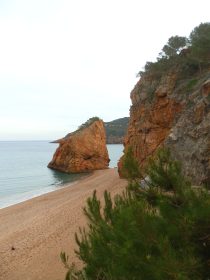 Sa Riera itself was almost completely closed - it's really a beachside holiday area. The beach itself is broad and sandy with luxury villas up each side of the bay. We head to the left of the beach towards the cliffs. There is a man-made path up along the cliff edge by the side of the bay. Going up it climbs quite high and is quite steep down to the side. Over the first headland you look down over the Plajta del Raco with a single large red 'island' standing up out of the beach almost like a Thai island. The path runs over the top of the beach before coming down on the other side to give you access to the beach. This is anudist beach in summer, and though strikingly pretty, it gets shady in late afternoon because of the cliffs.
Sa Riera itself was almost completely closed - it's really a beachside holiday area. The beach itself is broad and sandy with luxury villas up each side of the bay. We head to the left of the beach towards the cliffs. There is a man-made path up along the cliff edge by the side of the bay. Going up it climbs quite high and is quite steep down to the side. Over the first headland you look down over the Plajta del Raco with a single large red 'island' standing up out of the beach almost like a Thai island. The path runs over the top of the beach before coming down on the other side to give you access to the beach. This is anudist beach in summer, and though strikingly pretty, it gets shady in late afternoon because of the cliffs.
 Instead of going on to the beach, we follow the path around the headland and out over the rocks. We could continue over the sand to the main Platja de Pals centre. Like many areas that are dedicated to tourism, it's closed during winter. If you do come out of season, try to stay in one of the older towns and villages like Begur, Pals itself, Palafrugell or Palamos as these are working places and open all year round. Instead, we head up into the estate and follow the road past the houses that sit above the beach. Being close to the sea, these are expensive houses and well-kept. The path heads out from Platja de Pals past the various estates - there are a lot of houses around here but with few of them with year-round inhabitants. As you come to roundabout by the Spar Supermarket we cut off the main road and return to the woods.
Instead of going on to the beach, we follow the path around the headland and out over the rocks. We could continue over the sand to the main Platja de Pals centre. Like many areas that are dedicated to tourism, it's closed during winter. If you do come out of season, try to stay in one of the older towns and villages like Begur, Pals itself, Palafrugell or Palamos as these are working places and open all year round. Instead, we head up into the estate and follow the road past the houses that sit above the beach. Being close to the sea, these are expensive houses and well-kept. The path heads out from Platja de Pals past the various estates - there are a lot of houses around here but with few of them with year-round inhabitants. As you come to roundabout by the Spar Supermarket we cut off the main road and return to the woods.
As we approach Mas Tomasi we skirt around the other side than the side we went out. We run into a group of older people out collecting wild asparagus - it's common to see people collecting in the woods during spring, with wild asparagus being relatively thin compared to its cultivated cousin. The path cuts through the estate and out through the woods on the other side before returning to the roadway and then back to the church. In reality we probably could have started closer to Mas Tomasi and shaved a couple of kilometres without losing too much from the walk.
Neighbouring walks: Sa Tuna, Cap de Begur, Begur - Pals beach to Gola de Ter - Regencos to Pals via Quermany Gros and Petit - Evening walk Pals to Sant Feliu de Boada - Fornells and Aiguablava walk (GR92) - Begur, Ses Negres and Sa Riera
Swimming: Swimming and beach at Sa Riera (Begur) - Swimming at Platja de Pals and Platja Illa Roja
Events: Begur - Festa d'Indians
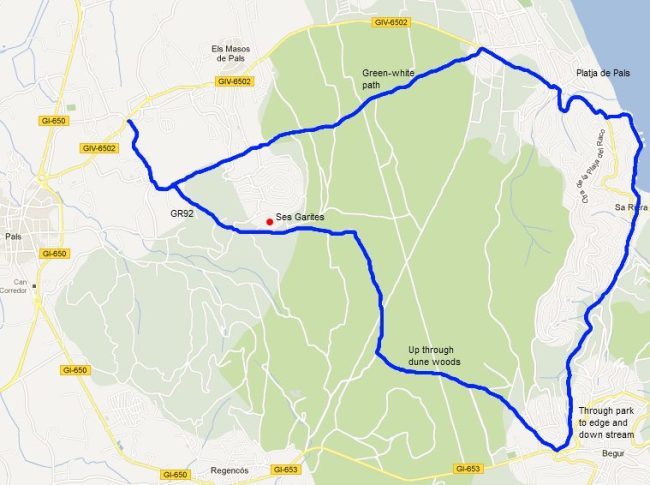
Caldes de Malavella
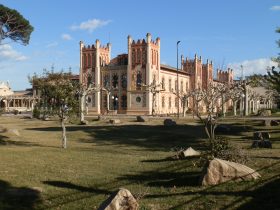 When we first seriously started coming up to the Costa Brava to see properties, we found a hotel deal in the Balneari Vichy Catalan in Caldes de Malavella. This won't make a bit of sense until you discover that Vichy Catalan is the most popular prestige mineral water in Catalonia and a Balneari is a hotel with natural mineral water spa and baths, in this case with natural thermal waters.
When we first seriously started coming up to the Costa Brava to see properties, we found a hotel deal in the Balneari Vichy Catalan in Caldes de Malavella. This won't make a bit of sense until you discover that Vichy Catalan is the most popular prestige mineral water in Catalonia and a Balneari is a hotel with natural mineral water spa and baths, in this case with natural thermal waters.
In the early part of the 20th Century prior to the 1930s, the prime resort and holiday locations for Catalonia weren't the sea or the coast, but water spas and water health treatments (similar to Bath or Malvern in the UK which had been established since the 18th Century). Towns like La Garriga closer to Barcelona and Caldes de Malavella became popular luxury resorts catering to the wealthy (other towns called Caldes also have hot springs, as does Badalona).
Caldes de Malavella is also a Roman town, a staging point on the Via Augusta that links Cadiz to Rome and as such it has the remains of the original Roman baths. It actually has several hot springs and several Balnearis in the town - one public and three others that have been taken over by spa-hotels or for hospital use - thermal and mineral waters for a long time have been considered to have health properties.
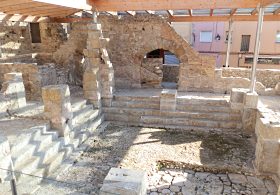 These types of spa and the use of mineral water for health benefits are extremely popular in France known as thermalisme and for preventative purposes thalassoterapie. So a local entrepreneur started bottling the water and named it after the most famous French Spa - hence Vichy Catalan. (Side note that Vichy, just north or Clermont Ferrand is a worthwhile overnight town if you are driving between the UK and Spain).
These types of spa and the use of mineral water for health benefits are extremely popular in France known as thermalisme and for preventative purposes thalassoterapie. So a local entrepreneur started bottling the water and named it after the most famous French Spa - hence Vichy Catalan. (Side note that Vichy, just north or Clermont Ferrand is a worthwhile overnight town if you are driving between the UK and Spain).
From the time, and because of the type of people who took the cure, the hotel for Vichy Catalan itself is very grand, built in a modernista fashion with parkland and is just next to the station. Unfortunately, somewhat later the company built a rather ugly bottling plant right next to the hotel so its splendor is diminished if you get the wrong viewing angle.
As mentioned it's not the only spa - Balneari Prats closer to the centre of town also offers a naturally heated outdoor swimming pool/spa. And there are actually several brands of mineral water companies from here - San Narcisco, Imperial and Malavella.
The reason for this walk though was the train station. Caldes de Malavella is now the most practical station for trains to Barcelona and Barcelona airport. Until the dualling of the C66, most people would have recommended using Flaca for trains, but with an easy quick ride, Caldes saves about 5 stations and half an hour on the train.
The walk starts at the station, and heads into town past the Balneari Vichy Catalan and across the main road and then past Balneari Prats. The town itself is not tourist-y and relatively small and indistiguished. However take the chance to explore and find the Roman baths and the church and some of the remaining markers from the town's former heydays.
To head out of town we followed the Rambla Recolons which turns to the left to become Rambla Rufi before finishing in a field. Walk across the field and follow the path through the woods following a small stream. We then found a path to the right up away from the stream and followed this until we reached a sand-track road at the top. From the road there are views across the valley of the Onyar south of Girona and across to snow capped Pyrenees (it's February which is the time of most snow - last year it reached down to the coast - but normally it's mild on the low lands with snow in the far distance). We then followed the path back and through some of the new estates through town.
In fact Caldes is surrounded by a number of urbanisations (housing estates), but with poor connections between the urbanisations and the town itself. We find ourselves walking through a lot of estates and while individual houses can be quite striking, the overall impression is often of a mish-mash of isolated houses with relatively few facilities.
Whereas UK estates tend to be built by one developer and so have a unified look, Spanish and Catalan urbanisations are usually sold as individual plots of land. Consequently they have a wide variety of building looks and types with not much thought to creating a coherent look, and with most of them built on a grid system, they can feel like they lack a centre and amenities. For a town like Caldes it means much of the population is not in the centre making the whole town feel disjointed despite its historic attractions.
Other visits: Cassa de la Selva - Hostalric stroll - Arbucies autumn walk - Lake at Sils - Castell de Montsoriu - Santa Coloma de Farners - Brunyola - Arbucies autumn walk - Llagostera to Sant Llorenç
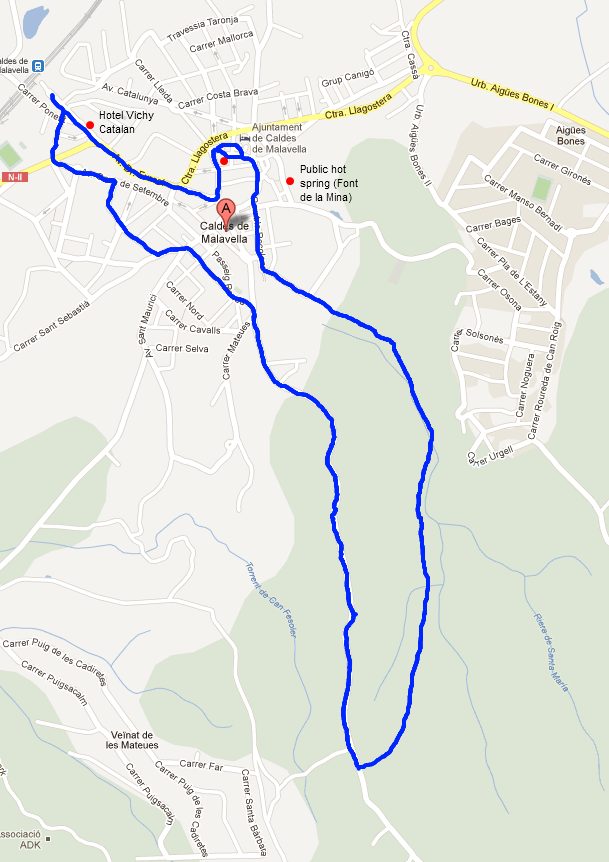
Calonge into the Gavarres
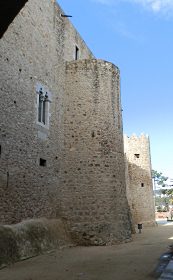 This time we have a walk that didn't really work out. The aim was to walk from Calonge up and over the first ridge of the Gavarres and then down to the ruins of the castle of Vila-Roma above St Maria de Bell-loc. We've walked to the castle before from Vila-Roma (just outside Palamos) and it's a very pleasant spring or autumn walk through the woods up the valley. In principle, it's also possible to reach the castle from Calonge, or from Vall-llobrega going over the hills at the side of the valley. Unfortunately we've now not managed to complete the path from either side. On the Vall-llobrega side we spent so long trying to navigate the housing estate that we ran out of time and now, on this walk, it felt like we were almost blown off the hill by the Tramuntana wind which was gusting at 60+km/h. And I don't know if it was just the wind, but once into the woods, the path just seemed a little dull up and down.
This time we have a walk that didn't really work out. The aim was to walk from Calonge up and over the first ridge of the Gavarres and then down to the ruins of the castle of Vila-Roma above St Maria de Bell-loc. We've walked to the castle before from Vila-Roma (just outside Palamos) and it's a very pleasant spring or autumn walk through the woods up the valley. In principle, it's also possible to reach the castle from Calonge, or from Vall-llobrega going over the hills at the side of the valley. Unfortunately we've now not managed to complete the path from either side. On the Vall-llobrega side we spent so long trying to navigate the housing estate that we ran out of time and now, on this walk, it felt like we were almost blown off the hill by the Tramuntana wind which was gusting at 60+km/h. And I don't know if it was just the wind, but once into the woods, the path just seemed a little dull up and down.
Obviously we knew there was a strong wind before we started, but we had decided to start from Calonge to be on the lee-side of the hills, hopefully having a little protection. It worked in some places but the wind was a problem. In reality we shouldn't have attempted a walk in the woods in a strong wind.
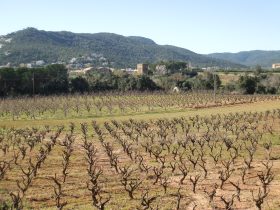 Calonge itself is a town I find a little odd. The old heart of the town suggests that at once point it would have been quite a prosperous place - it has a castle, a large prominent church with ornate carvings around the door and used to have a historic hospital from pre-industrialisation times. Unfortunately, though there has been restauration for some of the properties, in the centre there are still delapidated buildings and a faint sense of disrepair. The area around Calonge though is covered by urbanisations of villas all across the hillsides, all slightly disconnected from the town itself. And at the sea is St Antoni de Calonge - another area with large amounts of development. The presence of 'Indianas' - that it houses built towards the end of the 1800s and early 1900s by returning Catalans who had made their fortunes in Cuba, is another indication of how desirable this area once was (the most prominent Indiana house on a small hill above the plain can be seen from the C66 dual carriageway looking towards the sea). Despite this investment the village nucleus itself feels neglected and some of the estates and building projects feel badly planned with little thought to their overall visual impact.
Calonge itself is a town I find a little odd. The old heart of the town suggests that at once point it would have been quite a prosperous place - it has a castle, a large prominent church with ornate carvings around the door and used to have a historic hospital from pre-industrialisation times. Unfortunately, though there has been restauration for some of the properties, in the centre there are still delapidated buildings and a faint sense of disrepair. The area around Calonge though is covered by urbanisations of villas all across the hillsides, all slightly disconnected from the town itself. And at the sea is St Antoni de Calonge - another area with large amounts of development. The presence of 'Indianas' - that it houses built towards the end of the 1800s and early 1900s by returning Catalans who had made their fortunes in Cuba, is another indication of how desirable this area once was (the most prominent Indiana house on a small hill above the plain can be seen from the C66 dual carriageway looking towards the sea). Despite this investment the village nucleus itself feels neglected and some of the estates and building projects feel badly planned with little thought to their overall visual impact.
The walk then starts in the centre of the town. Next to the front of the church, a small archway leads through to the castle, once one of the largest in the area. The castle is from the 12th Century, and can be considered with the Castle at Castell d'Aro and the castle we were trying to walk to at Vila-roma. The port of Palamos was also a garrison town and naval base.
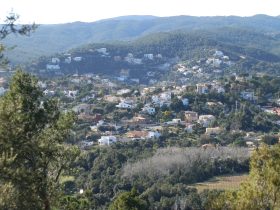 Head out along Carrer Major which becomes Carrer Pompeu Fabra. We're following a green-white local route, but it isn't marked with signposts until you're out of town a little, so it was a little confusing to get the first directions. Once out of town we head towards the hills past a farmhouse with a big wine-barrel outside it. The lower part of the walk is through vineyards and Castell de Calonge is one of the DO Emporda wine appellations (others include Mas Oller near Torrent and areas to the north such as Peralada).
Head out along Carrer Major which becomes Carrer Pompeu Fabra. We're following a green-white local route, but it isn't marked with signposts until you're out of town a little, so it was a little confusing to get the first directions. Once out of town we head towards the hills past a farmhouse with a big wine-barrel outside it. The lower part of the walk is through vineyards and Castell de Calonge is one of the DO Emporda wine appellations (others include Mas Oller near Torrent and areas to the north such as Peralada).
The path is easy to follow and quite broad with rolling countryside and views towards St Antoni to start with. Eventually the path turns up into the woods and into the hills, but seems relatively unremarkable - there are nicer bits of the Gavarres to walk. There are views towards Palamos and it's port and high-rises, but it feels more like a city viewscape. On this day though the sea looked extremely choppy, even from the hills. At the top of the path you come to the ridge. At this point the wind was gusting strongly and the children weren't too happy so rather than add to the length by going down to the former convent of Santa Maria de Bell-loc and the ruined castle, we turned up the road for a shortwhile until the next farm then came down to the left on the lee-side of the hill. The path down has views over the southern Gavarres and across to the estates (eg Mas Pere) around Calonge. The path winds through the woods, on occasion getting quite stoney underfoot. On a different day it would probably have been more enjoyable - but we were feeling a little wind-swept. At the bottom you come back down to the vineyards and an easy stroll into town.
Neighbouring walks: Calonge (Cami de Molins and over Cabanyes) - Bell-lloc and Castell de Vila-Roma (Palamos) - Mont-ras 'boar' walk - Mont-ras to Fitor and on to Fonteta and Vulpellac - Romanya de la Selva to Puig d'Arques
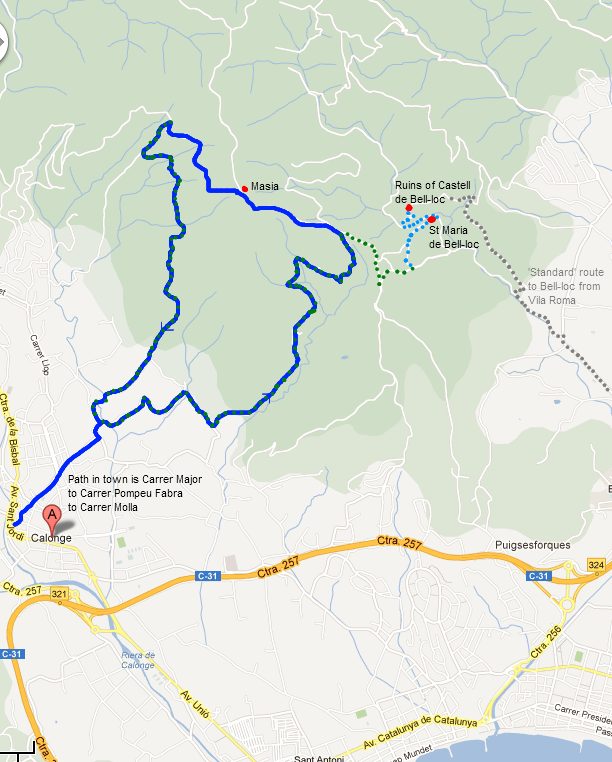
Platja d'Aro and S'Agaro
 Sometimes the Costa Brava can surprise you if you're prepared to explore.
Sometimes the Costa Brava can surprise you if you're prepared to explore.
The two main package holiday resorts to the north of Tossa are St Antoni de Calonge and Platja d'Aro. Both are built on big sandy bays and are family friendly places, but they were built as typical high-rise high-volume resorts in the 1960s and 70s.
It would be fair to say that over the year's they've mellowed - they're not party-party towns like Lloret (or Salou south of Barcelona) - but they remain package-holiday territory.
For Costa Brava locals Platja d'Aro (known as Fenals d'Aro until the 1960s) is actually one of the main shopping areas. Unlike other towns on the Costa Brava it has more of the standard Spanish high-street shops and it has the only McDonalds (or actually any chain fast-food restaurant) north of Lloret.
For locals the alternative is the longer trek into Girona or Figueres so as a town it remains busy throughout the year and in places has a somewhat upmarket feel.
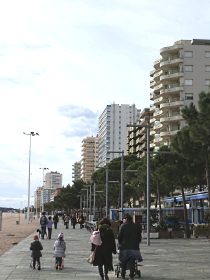 Having said that, it is still a relatively high-rise town (though nowhere near being like Benidorm) built broadly as a strip along the beach with estates of villas behind.
Having said that, it is still a relatively high-rise town (though nowhere near being like Benidorm) built broadly as a strip along the beach with estates of villas behind.
Holiday makers could spend their whole vacation in the town and on the broad long beach. Which would be a pity because to the north and to the south are a couple of gems.
The northern path (we'll add this later), is a series of small bays and rocky headlands. This walk we take to the south into the estate of S'Agaro - almost the Beverley Hills of the Costa Brava, a description which might surprise those who've only driven around the areas on the road between St Feliu and Platja d'Aro.
In reality, S'Agaro is one of the oldest estates on the Costa Brava. Conceived around 1916 with construction work from the 1920s onwards it was designed and conceived as an upmarket and exclusive estate built to an architect's view of idealised Catalan mansion-villa.
The S'Agaro estate itself is gated - to get access by car you have to pass through a security check point. And it has within it the Hostal de la Gavina 5-star hotel, famous for the number of A-list of Hollywood stars that have stayed there including John Wayne, Elizabeth Taylor, Rock Hudson and more recent stars like the Black Eyed Peas, and is connected to several Hollywood films made on the Costa Brava in the 1950s and 1960s.
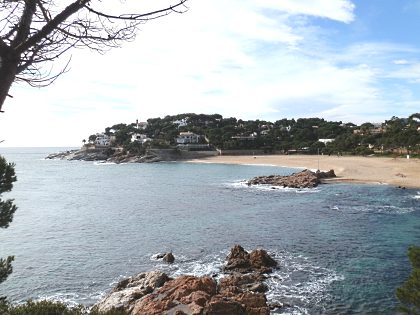 The walk itself starts in Platja d'Aro (we needed to go shopping), but if you just want to see S'Agaro and the next beaches, you could start near Port d'Aro marina.
The walk itself starts in Platja d'Aro (we needed to go shopping), but if you just want to see S'Agaro and the next beaches, you could start near Port d'Aro marina.
We took the sea on the way out - a classic Spanish beach-side passeo to start with which, in summer, has bars and restaurants spilling out across the terrace from the feet of the high-rises above.
At the end of the beach, the path turns along the river Riudaro. This can be dry in summer, but in winter there is water flowing - it actually links to a pleasant lake/nature reserve that marks the split between Platja d'Aro and Port d'Aro - though the water can be a little smelly as it dries after a wet patch.
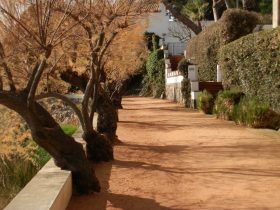 The path is now marked by the classic red-white flashes of the GR92. Don't turn back to the sea too early - you have to pass to the other side of the port, otherwise you won't be able to cross the marina's sea entrance.
The path is now marked by the classic red-white flashes of the GR92. Don't turn back to the sea too early - you have to pass to the other side of the port, otherwise you won't be able to cross the marina's sea entrance.
The port itself was full with luxury yachts and the path takes you round the back past the new flats and houses built to match.
At the end of the port road, you final reach the woods and a headland. Across the headland and the first surprise - a long sandy beach with rocks at each end and a small rocky presque-isle in the centre - the Platja de la Concha - a classic unspoilt half-moon bay.
 We walk across the beach to the other side and then up the steps on the other side. The path is broad and specially built running past the houses of the S'Agaro estate.
We walk across the beach to the other side and then up the steps on the other side. The path is broad and specially built running past the houses of the S'Agaro estate.
To the left, the sea side is rocky with very occasional very small pebbly bays. To begin with the houses and the walls of the houses are high and you can't see anything, but as you walk towards the middle part of the path, you get a glimpse of the mansions and villas and their gardens.
A rotonda built above the sea is at one corner and there are viewpoints along the coast.
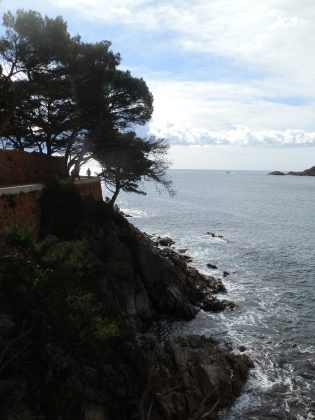 Around the final headland, the path turns to give a view of the beach at St Pol. Another broad sandy bay - bigger than Concha and really the second (and prettiest) beach for St Feliu.
Around the final headland, the path turns to give a view of the beach at St Pol. Another broad sandy bay - bigger than Concha and really the second (and prettiest) beach for St Feliu.
Instead of going to St Pol, we wanted to see some more of the S'Agaro estate and took the first path to the right past the Hostal de la Gavina. Initially we weren't sure how private the estate was, as it wasn't clear if the security staff would stop walkers, but there are paths (health walks) marked through the estate, so we think it's just cars that wouldn't be allowed in.
We broadly followed our nose through the estate, past a small church built at the high point, before finding more modern houses and then heading out and back to Platja d'Aro.
The route back into the town went past the attractions park (probably enjoyable for under 8s) and along the main shopping street.
Neighbouring walks: St Antoni de Calonge, Torre Valentina to Platja d'Aro (almost) - Platja Sant Pol to Sant Feliu de Guixols
Swimming: Swimming at the beach of Sa Conca (S'Agaro) - Swimming and beach at Platja d'Aro
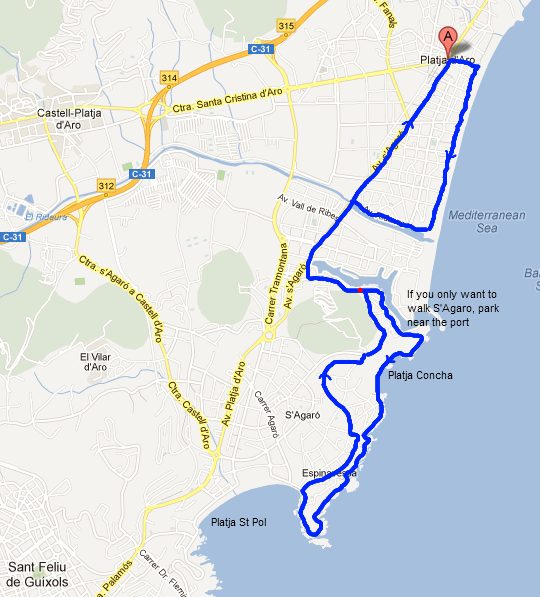
Far de Sant Sebastia (Llafranc) to Tamariu
 The idea was to try out the marked path to Tamariu from the lighthouse at Sant Sebastia above Llafranc then come back along the GR92 to complete the next stretch of the coast path for the blog.
The idea was to try out the marked path to Tamariu from the lighthouse at Sant Sebastia above Llafranc then come back along the GR92 to complete the next stretch of the coast path for the blog.
Sometimes though, when we go walking things don't quite turn out as planned as unfortunately the GR92 was being repaired (winter damage is a continual problem for the path) and so not accessible for the whole of the route. It was also a little overcast, so we'll have to repeat and get some of the classic bluesky photographs (see Tamariu to Llafranc revisited for an update).
Llafranc is an old fishing village with a harbour and large sandy beach, with chic restaurants along the promenade overlooking the sea (the Daily Telegraph describes it as che-che). Though small it is quite upmarket.
To the south is an easy walk around the headland to Calella (described in our Mont-ras to Llafranc and Calella walk).
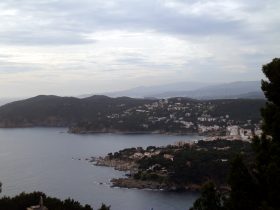 Along the coast to the north is the lighthouse of Sant Sebastia. If you see a postcard of the Costa Brava with a picture of a lighthouse, this is likely to be it.
Along the coast to the north is the lighthouse of Sant Sebastia. If you see a postcard of the Costa Brava with a picture of a lighthouse, this is likely to be it.
You can obviously walk up to the lighthouse from Llafranc, but having done that a few times, it's quite steep and all roadway and Llafranc can be difficult to find parking. So rather than start in the village we drive directly to the lighthouse (follow the Tamariu road out of Palafrugell) - this is both easier and gives a great view over the countryside and down the coast towards Palamos.
There is parking but it can be busy. We parked just under the hotel/restaurant just above the lighthouse itself.
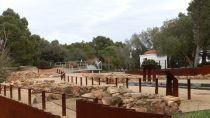 The walk starts and runs down past the excavation site of the Iberic village. We wanted to do a circular route, and we wanted to follow the marked path to Tamariu so we followed the path marked by green-white flashes which runs along the road away from the sea, eventually reaching the Palafrugell-Tamariu road.
The walk starts and runs down past the excavation site of the Iberic village. We wanted to do a circular route, and we wanted to follow the marked path to Tamariu so we followed the path marked by green-white flashes which runs along the road away from the sea, eventually reaching the Palafrugell-Tamariu road.
The marked path then crosses the Palafrugell-Tamariu road just to the right after the Llafranc junction, rather than down the hill towards Tamariu. On the other side of the road it directs you along a dirt track in among isolated houses in the woods.
The flashes are now yellow-white. Follow the track through the woods and keep looking out for the flashes. You would think the path would go down, but actually it goes up and stays high above the village following the tracks to the houses.
One of the tracks turns to the right, past a couple more houses and then you've got to look out for the turning. It's marked on the tree as you go past, but you have to keep an eye out for the flash as the path doubles back sharply into the woods and turns into a single-track footpath heading down.
This runs gently downhill through the woods to start with, before becoming quite a lot steeper. We had to support ourselves on the trees so as not to slip over.
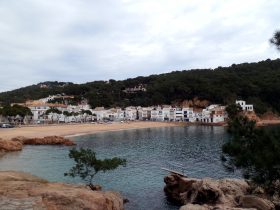 Eventually you reach the bottom and emerge at the top of an estate above Tamariu. Walk down through the estate (we found a short cut down a long flight of steps) before emerging towards the bottom by Camping Tamariu and out along the road to the village itself.
Eventually you reach the bottom and emerge at the top of an estate above Tamariu. Walk down through the estate (we found a short cut down a long flight of steps) before emerging towards the bottom by Camping Tamariu and out along the road to the village itself.
While Tamariu bustles in summer, in winter it tends to close down almost completely. The shops and restaurants were all closed in January. This is contrast to Llafranc or Calella where there is always some activity all year around and obviously in total contrast to the larger neighbouring towns of Begur or Palafrugell which have large permanent populations.
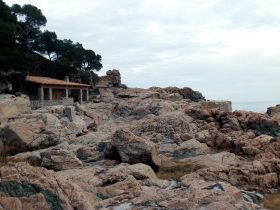 The GR92 runs into the village, before leading out across Tamariu's beach where it runs to the left of the beach, climbing over rocks and out to the headland.
The GR92 runs into the village, before leading out across Tamariu's beach where it runs to the left of the beach, climbing over rocks and out to the headland.
Around the headland you have to cross a rocky outcrop dodging among the rock pools - there is no easy flat path here.
Our intention was to follow the path all the way around to Cala Pedrosa but subsidence and some works on a local villa meant it was impossible to follow the path around. We have taken the path before and it is quite wild. There is also a step descent down into Cala Pedrosa.
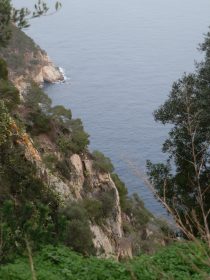 Instead we had to head back up to the main road and follow the road out. The road is bendy and though there is not much traffic at this time of year, there isn't any separated walking space.
Instead we had to head back up to the main road and follow the road out. The road is bendy and though there is not much traffic at this time of year, there isn't any separated walking space.
There are two large estates off the road - the Musclera - a large house with gardens that extend down to the sea; and La Pedrosa which takes up all of the next hillside. After La Pedrosa estate take a track to your left.
This rejoins with the GR92 as it emerges from Cala Pedrosa. The path continues straight on past the farmhouses and back into the woods.
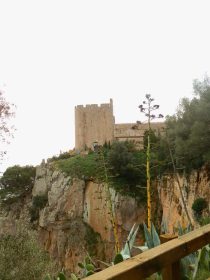 In the woods, the path climbs gently and you slowly rise above the sea. As you get to the last stretch, the path is about 150m above the sea and though not a vertical cliff, to your lefthand side, the edge falls away below you steeply.
In the woods, the path climbs gently and you slowly rise above the sea. As you get to the last stretch, the path is about 150m above the sea and though not a vertical cliff, to your lefthand side, the edge falls away below you steeply.
For those uncomfortable with heights the height, closeness of the edge and narrowness of the path potentially make this a little nerve-wracking. As you reach the top you'll see the watchtower at the back of the hotel. The path climbs up steps and then emerges at the top. The path skirts the watchtower and along back to the hotel.
Update: The path to Cala Pedrosa has been reopened with a new high quality walkway (Nov 2013). The route down to Cala Pedrosa also seems to have more guiderails/fences making the route down (or up) easier.
Neighbouring walks: Mont-ras to Calella de Palafrugell and Llafranc - Palafrugell, Tamariu, Begur residential and Esclanya - Calella de Palafrugell/Cap Roig to Castell - classic wild Costa Brava - Fornells and Aiguablava walk (GR92) - Eulogy to the Ruta del Tren Petit (Palafrugell, Palamos, Mont-ras and Vall-llobrega)
Swimming: Swimming at the beach at Tamariu

Aiguamolls d'Emporda (Empuriabrava)
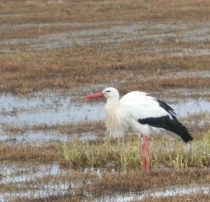 The Aiguamolls d'Emporda are a natural park of wetlands and marshes situated on the coast of the Gulf of Roses between the mouth of the Fluvia and Muga rivers between St Pere Pescador and Empuriabrava. Dedicated as a protected area, they are a haven for bird watchers.
The Aiguamolls d'Emporda are a natural park of wetlands and marshes situated on the coast of the Gulf of Roses between the mouth of the Fluvia and Muga rivers between St Pere Pescador and Empuriabrava. Dedicated as a protected area, they are a haven for bird watchers.
If you know of the Slimbridge Wildfowl and Wetlands reserve in Gloucestershire, then the Aiguamolls are similar, but 16 times bigger (Slimbridge is 3 sq km, the Aiguamolls are 48 sq km) and with more exotic species including storks and flamingos.
Even if you aren't much of a bird watcher, the number and variety of species makes it well-worth a visit and it's not just birds. For instance we saw deer that had just left their footprints on the beach.
The guide recommends a mosquito repellent in hotter months, and suggests that March and October are the best times to go for the annual migrations.
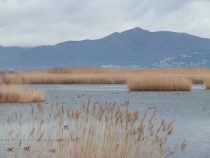 The Aiguamolls (sea marshes) were once much larger.
The Aiguamolls (sea marshes) were once much larger.
Older maps show a large lake that extended from Castello d'Emporda to the sea. And as we've seen on other walks, the footprint of sea level and the floodwaters of the three main rivers (the Ter, Fluvia, and Muga) define the historical siting of villages but also give vast open views across the plains to the mountains in the background.
The Aiguamolls themselves were originally part of a rice-growing farm that was bought by property developers who wanted to drain and canalise the land to create an extension to the neighbouring resort town of Empuriabrava. However a Catalan outcry in the mid-1970s saw the Catalan government take over the land and so the creation of the park as it is today.
If you want to look at how the developers were thinking, you can visit or see the neighbouring Empuriabrava with its network of canals/marina with each house or hotel having direct access to the water and their own mooring point.
As mentioned, this building only exists because of the draining of previous marshes and lakeland. So modern villages and highrise hotels are now found close to a beach whereas older villages would have been built higher up because of the risk of flooding.
If sea levels rise, most of these newer resorts (including Sant Antoni de Calonge and Platja d'Aro) would be directly affected.
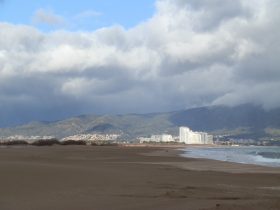 The walk itself starts at the main information centre for the Aiguamolls. It is clearly marked as a turn-off of the road from St Pere de Pescador to Castello d'Emporda.
The walk itself starts at the main information centre for the Aiguamolls. It is clearly marked as a turn-off of the road from St Pere de Pescador to Castello d'Emporda.
The day we visited it started with drizzle so the photos don't have the classic blue sky you would see in summer.
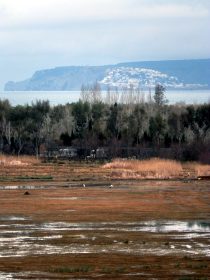 The landscape itself is naturally very flat with ponds and water courses reminiscent of the Norfolk broads or the Fens.
The landscape itself is naturally very flat with ponds and water courses reminiscent of the Norfolk broads or the Fens.
The park has several itineraries and the paths are flat and broad.
To watch the birds, they have placed a number of cabins (used as hides) where you can go to watch the birds. There is also information about what birds and animals to look for.
We had hoped to see flamingos (you can also see flamingos on the etangs close to Perpignan) but had to make do with storks, teals and a marsh harrier.
The route we took lead from the main information point along the paths to three towers. Called sitges, these were originally used for drying rice, but when the government took the park over, one was converted into an observation tower and is now the highest point in the park.
From the platform at the top you can see across the wetlands to the sea, the towns of Empuriabrava and Roses, around to the Pyrenees and to Montgri to the south.
From the observation tower we continued away from the centre of the park. Eventually reaching the limits of the park and then down a road towards a campsite (closed during winter) and then followed a footpath around the campsite and down to the sea.
The Aiguamolls are large so this stretch of walk from the centre to the sea is about 5km in length. In practice when we go back we're more likely to stay in the main park area and spend more time looking at the birds.
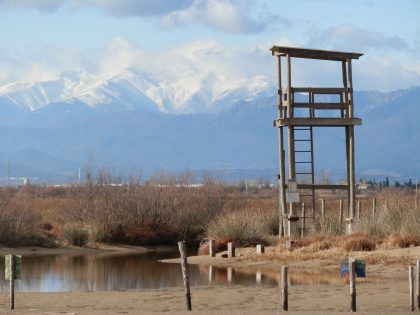 At the beach is a viewing tower and we saw signs that confused us. Some signs seemed to say the beach was closed, but we had the guide-leaflet which said this stretch of beach could be walked on but is closed for breeding, between April and June. And other signs seemed to indicate that it was OK to walk but to avoid the dune-line where the animals were.
At the beach is a viewing tower and we saw signs that confused us. Some signs seemed to say the beach was closed, but we had the guide-leaflet which said this stretch of beach could be walked on but is closed for breeding, between April and June. And other signs seemed to indicate that it was OK to walk but to avoid the dune-line where the animals were.
In the end we decided to do the walk, but kept close to the sea. As we were walking we found deer footprints in the sand and we saw a herd of deer in among the dunes.
The walk along the beach is long (about another 5km) and we had hoped to re-enter the park at the next path. However, the next path was marked by another observation tower, but the route to the tower was blocked by water.
We weren't sure if we were allowed to cross the dunes to reach the tower. We did try, but the path itself from the observation tower was also flooded so we ended up having to walk to the end of the beach just by Empuriabrava.
The river Muga reaches the sea here and splits the beach preventing us from going into the town. Instead we followed around the edge of a campsite and then up along by the river before cutting back into the fields and finally re-entering the park in amongst cows and sheep (the sign posting isn't great around the campsite).
Neighbouring walks: Escala, St Marti d'Empuries and beyond - Roses - Canyelles beaches to Cap Falconera - Castello d'Empuries - Sant Pere Pescador river Fluvia - Bellcaire d'Emporda, Tor and Albons
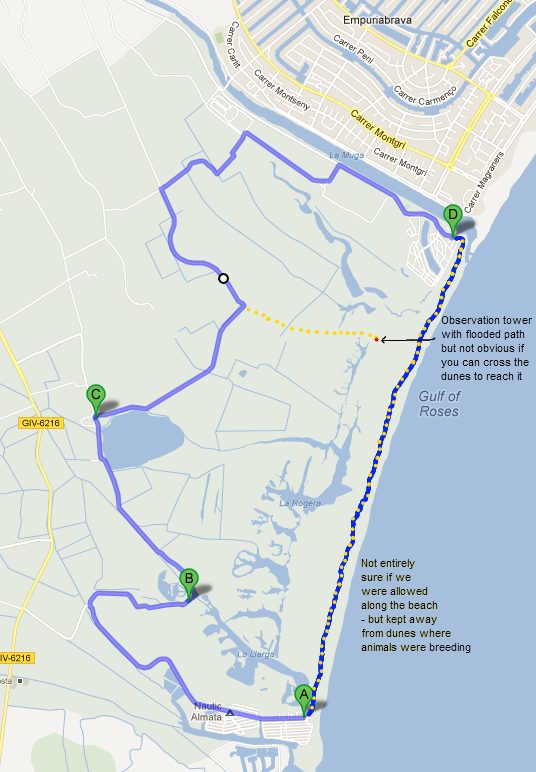
Sobrestany, Montgri and Bellcaire d'Emporda
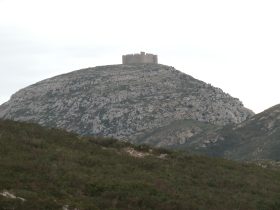 The mountain of Montgri stands dominates the plains of the Emporda and having already taken the path up to the Castle from the town of Torroella, this was a chance to visit the mountain from 'the back'. This route takes you up the other side from the village of Sobrestany (literally 'above the lake') just outside Bellcaire d'Emporda on the L'Escala side of Montgri. Like Ullastret's lake, Bellcaire also had a lake which was drained in the 19th Century. Bellcaire d'Emporda's other claim to fame is that it's the home village of Tito Vilanova, coach of Barcelona FC.
The mountain of Montgri stands dominates the plains of the Emporda and having already taken the path up to the Castle from the town of Torroella, this was a chance to visit the mountain from 'the back'. This route takes you up the other side from the village of Sobrestany (literally 'above the lake') just outside Bellcaire d'Emporda on the L'Escala side of Montgri. Like Ullastret's lake, Bellcaire also had a lake which was drained in the 19th Century. Bellcaire d'Emporda's other claim to fame is that it's the home village of Tito Vilanova, coach of Barcelona FC.
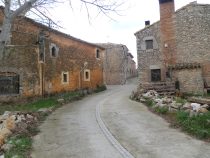 The walk itself has a range of contrasts and it's strongly recommended that you take a map. The end path down towards Bellcaire is marked with a dashed-line on our Emporda Costa Brava maps. Our experience with the smaller paths marked on the maps has been variable - sometimes they get heavily overgrown and seem to disappear, sometimes they are easy and obvious. Further down towards Sobrestany we actually missed the path back that we really intended to take and ended up with a longer loop.
The walk itself has a range of contrasts and it's strongly recommended that you take a map. The end path down towards Bellcaire is marked with a dashed-line on our Emporda Costa Brava maps. Our experience with the smaller paths marked on the maps has been variable - sometimes they get heavily overgrown and seem to disappear, sometimes they are easy and obvious. Further down towards Sobrestany we actually missed the path back that we really intended to take and ended up with a longer loop.
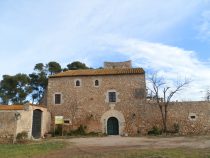 The walk starts easily enough along the flat following the untarmaced road from the parking area in the village (more a hamlet) itself. Sobrestany has signposts for an animal park which seems to have recently closed and you pass the remnants of this park. Once past the park, is a 'colonias' house with a sundial and tower. Colonias are holidays taken by schoolclasses with all the children together. They are very popular with Catalan and Spanish schools with most year groups having at least one trip away to a colonia for a few days during the year. The colonia itself is like a hostel for children, but with activities outside. For this particular colonia you can see the swimming pool, diving boards and zipwires outside for instance.
The walk starts easily enough along the flat following the untarmaced road from the parking area in the village (more a hamlet) itself. Sobrestany has signposts for an animal park which seems to have recently closed and you pass the remnants of this park. Once past the park, is a 'colonias' house with a sundial and tower. Colonias are holidays taken by schoolclasses with all the children together. They are very popular with Catalan and Spanish schools with most year groups having at least one trip away to a colonia for a few days during the year. The colonia itself is like a hostel for children, but with activities outside. For this particular colonia you can see the swimming pool, diving boards and zipwires outside for instance.
From the house the path continues into the woods. At the signpost marking the nature reserve of the Dunes Continental, turn right into the woods and start following the stream. The woods have grown on a sand base (and so Dunes) giving the path a very soft bed. The same type of sandy/dune bed can also be found in the woods near Mas Tomasi in Pals and presumably was established when the sand off the beaches was blown by the North wind until it met the mountain where it was deposited. From what we've seen so far, there is nothing equivalent on the north side of the mountain.
After a while through the woods, the path meets the road again and continues its gentle climb. At a sharp right a track ahead is marked with a 'no vehicles' sign. Follow the footpath and stream up the valley. The woods are fairly open and still sandy underfoot and there was plenty of evidence that the path was well used by mountain bikers and other walkers.
As you would expect, the path continues to rise as it tracks the stream up to it's head. At the top. towards the valley head, the path becomes steeper as it climbs out of the valley and past some stone piles that look as if they might have once been buildings. For this particular walk, we were in hunting season and saw quite a number of hunters in the woods and heard a few shots.
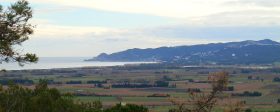 After the top of the valley, the footpath comes down to meet the GR92 path. The GR92 covers some fabulous routes and would be worth writing about all on its own. This stretch is popular with walkers and there are signs at various points of interest. This time we follow the GR92 to the right along the ridge of the hill which should have views to the north and south, but unfortunately the trees limit the views.
After the top of the valley, the footpath comes down to meet the GR92 path. The GR92 covers some fabulous routes and would be worth writing about all on its own. This stretch is popular with walkers and there are signs at various points of interest. This time we follow the GR92 to the right along the ridge of the hill which should have views to the north and south, but unfortunately the trees limit the views.
Eventually you pass across the top of the Torre Vella urbanisation. Between the houses you can look out across the plains of the river Ter and the bay of Pals towards Begur in the south. After the houses peter out, you find yourself on a tarmacked road and follow this to a picnic area at the Casa de Dunes. The view is much clearer here and it marks the start of the GR92's climb up towards the Montgri Castle
However, this time we didn't want to go up to the Castle and instead follow the route around the back of the hill - it's marked with a green and white flash on the trees. This path branches off the road and climbs up a rocky valley past a ruined farmhouse on the right and indications of stone walls built a long time ago. The climb up is steep enough to make you puff. Eventually you reach the top and the landscape is transformed into low gorse and bushes of rosemary. At this point we took a right hand fork away from the marked green-white path. It almost looks like it will take you to a cliff edge, but it doesn't. You will also have great views over the Gulf of Roses towards Cap de Creus and the plains of the Fluvia river.
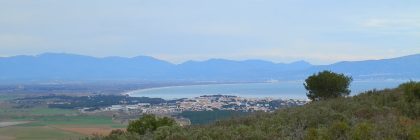 Unlike the soft dune path through the woods, this path is rocky and stony - classic Montgri - and you can feel the stones even through thick soled shoes. The path cuts through the gorse and up and down two or three valley heads before reaching the top of a small hill (Puig de les Cogullades). From this viewpoint we could see the mountains to the west above Bellcaire brilliant white and covered with snow, to the north the fields with water in them just outside Sobrestany and out along the plain to Empuriabrava and the white houses of Roses dotting the headland on the other side of the bay. To the east is Escala with the tower at Montgo just big enough to rise up and be seen above the hillside behind you. The low vegetation means that you have a clear view the whole time all the way back to Bellcaire.
Unlike the soft dune path through the woods, this path is rocky and stony - classic Montgri - and you can feel the stones even through thick soled shoes. The path cuts through the gorse and up and down two or three valley heads before reaching the top of a small hill (Puig de les Cogullades). From this viewpoint we could see the mountains to the west above Bellcaire brilliant white and covered with snow, to the north the fields with water in them just outside Sobrestany and out along the plain to Empuriabrava and the white houses of Roses dotting the headland on the other side of the bay. To the east is Escala with the tower at Montgo just big enough to rise up and be seen above the hillside behind you. The low vegetation means that you have a clear view the whole time all the way back to Bellcaire.
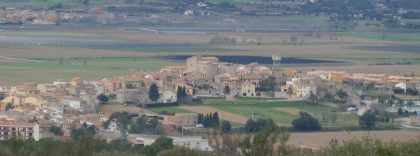 Our aim, at least on the map, was to find a direct path that is marked towards Sobrestany, but among the rocks and gorses we managed to miss the junction. In the end it didn't matter. The narrow track became a wider track for 4x4s and we followed it to the outskirts of Bellcaire (we didn't visit the centre), before following the road back to Sobrestany.
Our aim, at least on the map, was to find a direct path that is marked towards Sobrestany, but among the rocks and gorses we managed to miss the junction. In the end it didn't matter. The narrow track became a wider track for 4x4s and we followed it to the outskirts of Bellcaire (we didn't visit the centre), before following the road back to Sobrestany.
Neighbouring walks: Torroella de Montgri castle - L'Escala Riells to sea cliffs and viewpoint of Montgo - L'Estartit to Cala Pedrosa and Cala Ferriol - Bellcaire d'Emporda, Tor and Albons - Torroella de Montgri and Ulla
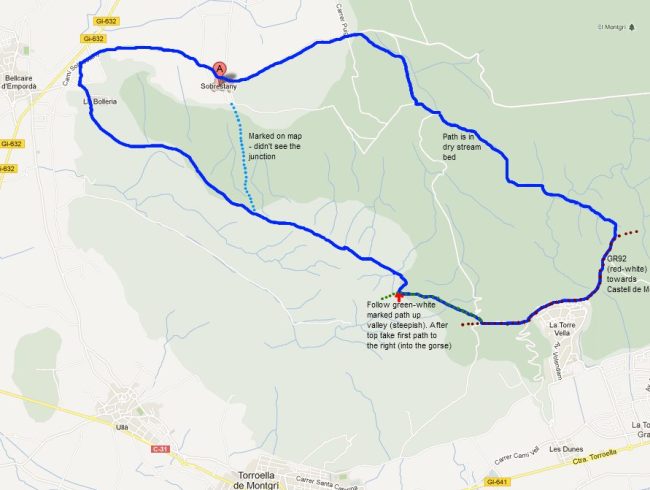
Roman fort at St Julia de Ramis (Girona)
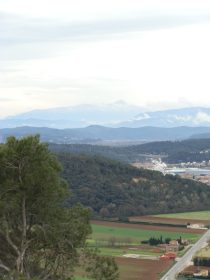 Geographically and historically Girona is a key gateway to Spain and the Iberian Peninsular. Though Figueres and the pass at Le Boulou (El Volo)/Le Perthus over the Pyrenees mark the border (since about 1659) and start point into the plains of Emporda, the plains of Emporda themselves are blocked to the west by the foothills of the Pyrenees and to the south by the Gavarres. Consequently any invading army wanting to go south for all practical purposes has to pass through Girona to be able to go south, or any army coming from the south has to pass through Girona to go north.
Geographically and historically Girona is a key gateway to Spain and the Iberian Peninsular. Though Figueres and the pass at Le Boulou (El Volo)/Le Perthus over the Pyrenees mark the border (since about 1659) and start point into the plains of Emporda, the plains of Emporda themselves are blocked to the west by the foothills of the Pyrenees and to the south by the Gavarres. Consequently any invading army wanting to go south for all practical purposes has to pass through Girona to be able to go south, or any army coming from the south has to pass through Girona to go north.
As a result Girona and the hills around Girona have been of major strategic importance for the numerous invasions and incursions across the Spanish French border. According to reports, Girona itself has been beseiged twenty five times in its history. As a result Girona is surrounded by castles and fortifications in various states of disrepair. The city itself was heavily walled during the 17th century, though many of these fortifications have been removed.
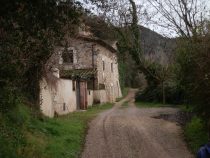 For the Romans, Girona (Gerunda) was a key strategic outpost on the Via Augusta (now AP7 and N II) leading from the south of Spain all the way to Rome, whilst the easterly route to the coast would have take the Roman's towards the Empordan Plain to the East and out to the Roman city of Empuries following the river Ter. At the point the Ter curves round the Gavarres it passes through the narrow valley between Sant Julia de Ramis and Campdora. The hills around this point have several castles and fortifications that can be seen from the autoroute, but it also remains a major junction point, consequently walking in what is a historic area, has to be done with a background of road and rail noise.
For the Romans, Girona (Gerunda) was a key strategic outpost on the Via Augusta (now AP7 and N II) leading from the south of Spain all the way to Rome, whilst the easterly route to the coast would have take the Roman's towards the Empordan Plain to the East and out to the Roman city of Empuries following the river Ter. At the point the Ter curves round the Gavarres it passes through the narrow valley between Sant Julia de Ramis and Campdora. The hills around this point have several castles and fortifications that can be seen from the autoroute, but it also remains a major junction point, consequently walking in what is a historic area, has to be done with a background of road and rail noise.
The walk starts in Sant Julia de Ramis by the Ajuntament. To reach it you have to take a right off the N II heading north. Unfortunately it's easy to miss if you're not sure where you're going, so we had to continue on the N II to the roundabout and turnaround before finally being able to make the junction. There is a map of the walk outside the Ajuntament - we kept it simple and just followed the marked route. This takes you along out along the flat of the river following the Ter as it flows through the valley. Around are the road and railways but the walk itself is pleasant enough if unspectacular. We saw our first snowdrops in Spain. The walk continues at the base of the hill past a set of caves and out into the plains behind Celra. The Ter valley at this point all the way to Flaca is planted with birch trees. We were trying to work out why such flat and apparently arable land wouldn't be used for crops and wondered if this is an area that would have been flooded by the Ter with the spring snow melts (before the Ter dam was built higher up) which would have precluded other types of crops?
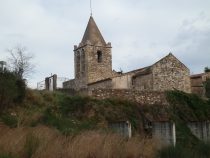 On the opposite side of the valley is a large disused factory built of brick. With the noise of the traffic at this point it feels more like a walk with industrial heritage. Celra itself has a couple of historical factories in a modernista style, but that is for another day. Eventually the path curves turns to the left (careful with the signpost, the sign points right, but the arrow on the sign points left) and starts to climb into the woods passing under the N II. And then it becomes a pretty wooded walk up to the top following the sign posts.
On the opposite side of the valley is a large disused factory built of brick. With the noise of the traffic at this point it feels more like a walk with industrial heritage. Celra itself has a couple of historical factories in a modernista style, but that is for another day. Eventually the path curves turns to the left (careful with the signpost, the sign points right, but the arrow on the sign points left) and starts to climb into the woods passing under the N II. And then it becomes a pretty wooded walk up to the top following the sign posts.
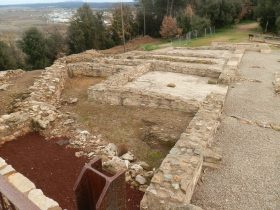 At the top is a small church - you can climb the tower. There are views out along the Ter towards the sea and you can see Roses, the small hill at Montgo (near L'Escala) and the castle on the Montgri mountain in the distance. Below, along the N II to the north you'll see the next castle (Madremanya - it looks prettier from further away than from up close). Then follow the path from the church to the Roman remains of the fort Castellum Fractum. This has been excavated and there are signs and information. From the fort you can look south down the Onyar valley towards the mountain of Montseny and on the other side of the valley is Campdora and further castle ruins.
At the top is a small church - you can climb the tower. There are views out along the Ter towards the sea and you can see Roses, the small hill at Montgo (near L'Escala) and the castle on the Montgri mountain in the distance. Below, along the N II to the north you'll see the next castle (Madremanya - it looks prettier from further away than from up close). Then follow the path from the church to the Roman remains of the fort Castellum Fractum. This has been excavated and there are signs and information. From the fort you can look south down the Onyar valley towards the mountain of Montseny and on the other side of the valley is Campdora and further castle ruins.
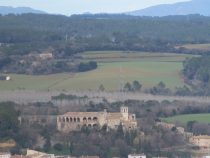 The Roman fort is not the fort that you can see from the autoroute. To reach this area you have to continue the loop around the top and you eventually reach the wall of Castell Forti. This was built in the 19th century and when we were there was totally closed off for works. The signpost said it was a private property, so I do not know if it will be open to the public in future.
The Roman fort is not the fort that you can see from the autoroute. To reach this area you have to continue the loop around the top and you eventually reach the wall of Castell Forti. This was built in the 19th century and when we were there was totally closed off for works. The signpost said it was a private property, so I do not know if it will be open to the public in future.
The road down then brings you back to Sant Julia.
Girona walks: Celra, Juia and the Castle of Palagret - Girona valley of Sant Daniel - Girona and Castell de St Miquel - Cervia de Ter - Bascara - horses, fords and lost - Palol de Revardit to La Mota - Bescano, River Ter and free-style kayaking - Celra, Juia and the Castle of Palagret

Calella de Palafrugell/Cap Roig to Castell - classic wild Costa Brava
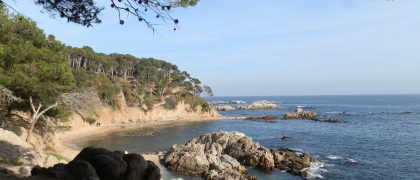 Costa Brava means wild coast, but if all you see are the main bays and resorts Brava can seem anything but wild.
Costa Brava means wild coast, but if all you see are the main bays and resorts Brava can seem anything but wild.
Unlike the French Riveria where you can practically drive along the cliff top and see the coastline, the Costa Brava is a little more hidden and like many places in this area, you really need to get out of the car to appreciate what it offers.
This walk runs from the botanical gardens at Cap Roig above Calella de Palafrugell to the beach at Castell and takes you past some of the classic 'wild' natural unspoilt bays and coves of the Costa Brava.
Cap Roig itself is a 'castle' and gardens built from 1927 onwards by a Russian emigre Nicolai Woevodsky and his aristocratic English wife Dorothy Webster just above Calella de Palafrugell.
The castle itself was designed as their dream house, but they also established the gardens and bought much of the neighbouring woodland which are now part of the Cap Roig-Castell protected area.
Cap Roig Castle itself is situated to the south of Calella de Palafrugell on the cliffs with views to Calella de Palafrugell and Llafranc.
At the time the castle was built, Calella de Palafrugell in the 1920s was little more than a small group of houses by Port Bo - the current heart of the village. However, in order to raise money to build the Cap Roig castle, Woevodsky and Webster introduced an number of other wealthy English aristocrats to the area, in some ways helping to establish the first international interest in the Costa Brava.
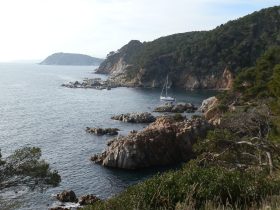 The castle itself and gardens are now owned by a public foundation and the public can now pay to access the botanic gardens (or it's free for La Caixa account holders).
The castle itself and gardens are now owned by a public foundation and the public can now pay to access the botanic gardens (or it's free for La Caixa account holders).
The woodland and natural areas surrounding Cap Roig however are freely open to the public for walking, though car access is normally restricted during the main summer months.
If you're interested in music, Cap Roig is the venue for a series of music concerts during the summer and has played host to Sting, Tom Jones, Tony Bennett, Bob Dylan, Kiki Tekawana, Simple Minds, Lady Gaga and a host of other local and world famous artists.
Our walk could start by parking the car in the car park at Cap Roig itself, but this time instead we start in Calella and park just above the bay of El Golfet where there is easy parking just off the road (at least outside the high season).
A diversion down a flight of stairs will take you down to a viewing point over the pebble beach of El Golfet bay, the last of the four beaches of Calella de Palafrugell.
We're keeping to the road though as it snakes up to the upper estates above Golfet.
The road splits at the top of the hill just before the farm on the entrance road towards Cap Roig - left to Cap Roig or upwards to the top estate or a signposted track in front of us.
This particular crossroads point meets with several paths including those from Ermedas and Mont-ras. It makes it a good starting point if you want to explore the fields and masia farms in the hills and plains away from the coast (also see the Ruta del Tren Petit).
We follow the signposted path towards Platja de Castell. At one point we could pass through the Cap Roig car park and reach the path on the other side, but this has been closed off, so the track is the main access to the woods.
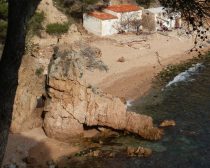 We walk following the track past the boundary of the Cap Roig estate - in winter some brave car drivers use the path. In summer it is usually closed off to all but the people who live in the scattered houses in the woods.
We walk following the track past the boundary of the Cap Roig estate - in winter some brave car drivers use the path. In summer it is usually closed off to all but the people who live in the scattered houses in the woods.
We follow the track as it climbs gently into the woods up to a fiveways point, again with a signpost.
To the left we can see two gate posts and a track that winds down the hillside towards the sea. This is the entrance to the Mont-ras bay of El Crit.
We follow the path down the cliffs to a clearing at the bottom just above the beach. In principle, people can drive down, but the path is steep and pitted and we've seen cars that have become trapped at the bottom. unable to make it back up the slope.
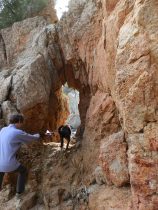 From the clearing above the beach there is a set of steps and small wooden bridges lead down to the bay. In the bay is a small fisherman's hut/refuge and when we were there we were surprised by the number of families and nordic walkers - normally it's quite quiet, but from time to time the Montrasians make family trips to the beach.
From the clearing above the beach there is a set of steps and small wooden bridges lead down to the bay. In the bay is a small fisherman's hut/refuge and when we were there we were surprised by the number of families and nordic walkers - normally it's quite quiet, but from time to time the Montrasians make family trips to the beach.
El Crit itself is a sandy beach under the cliffs, but with a rocky bay and just off the bay are some small islands. It's excellent for snorkelling, though for swimming in the bay, some swimming shoes or flippers are recommended to protect your feet.
To the right is a wall of rock, but with a hole in the middle. We go through the hole to the next bay, this time stonier.
Ahead of us is a stairway up the cliff, but the bottom has been washed away, so to reach it we have to scramble up the rocks at the bottom. After this scramble the path is well laid and easy to follow.
We go over the headland and then come down at to another fishing hut which marks the start of a series of sandy bays. These bays are isolated and natural and attract naturists in the summer. Even in January someone was sunbathing naked on one of the bays.
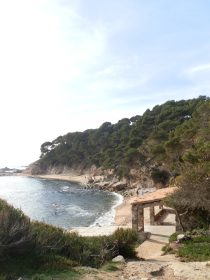 The path then follows the beaches for as long as you can along Cala Estreta ('narrow bay') and round three or four small sandy thin beaches.
The path then follows the beaches for as long as you can along Cala Estreta ('narrow bay') and round three or four small sandy thin beaches.
Eventually the path leaves the beaches and climbs into the next headland and then above Cala Corbs. In the bay beneath us we were lucky enough to see cormorants playing in the shallows of the beach.
The path then passes through a car park to meet the track at the back. The footpath climbs to the left up and over the top of the next cliff. It's steep and relatively close to the cliff's edge.
Climb all the way to the top and you are greeted with a view over the ruins of the Iberic village and ahead of you Castel, La Fosca and Palamos.
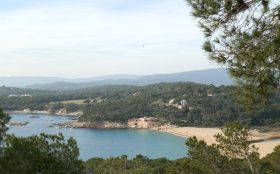 We descend through the woods to Castell beach and then follow the road past the car park and back. Our aim was to take the wood route back via the view point at Roques d'Ase but we didn't take the first left which we should have and instead continued past the abandoned Mas Canyet and along the track that connects the houses above the bays. The track is OK, but we would have preferred walking the wooded path back.
We descend through the woods to Castell beach and then follow the road past the car park and back. Our aim was to take the wood route back via the view point at Roques d'Ase but we didn't take the first left which we should have and instead continued past the abandoned Mas Canyet and along the track that connects the houses above the bays. The track is OK, but we would have preferred walking the wooded path back.
Neighbouring walks: Mont-ras to Calella de Palafrugell and Llafranc - Platja de Castell and La Fosca - La Fosca to Palamos - Far de Sant Sebastia (Llafranc) to Tamariu - Eulogy to the Ruta del Tren Petit (Palafrugell, Palamos, Mont-ras and Vall-llobrega)
Swimming and canoeing: Beach at Platja de Castell - swimming and canoeing - Swimming and wild beaches of Castell-Cap Roig
Visit: Gardens of Cap Roig - Palafrugell
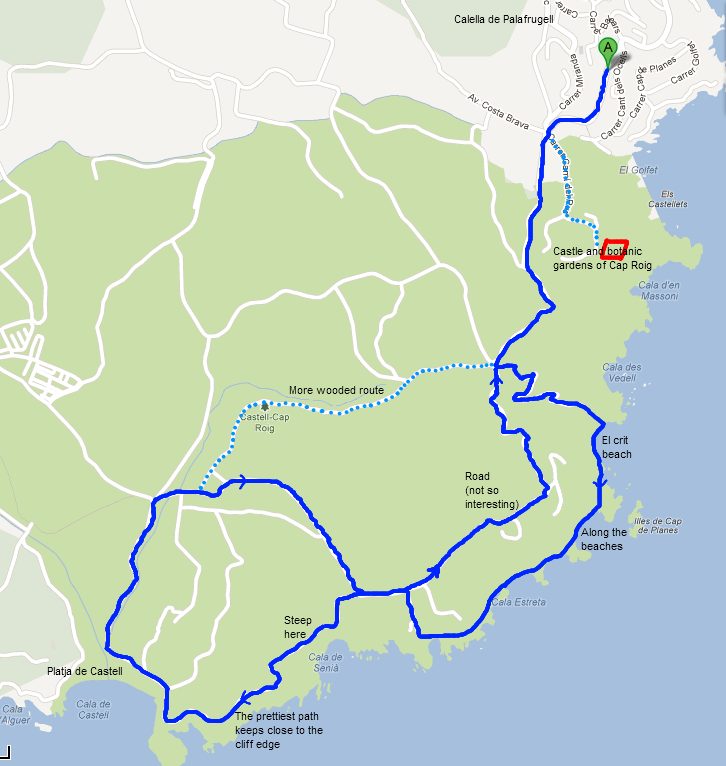
Rupia and Foixa
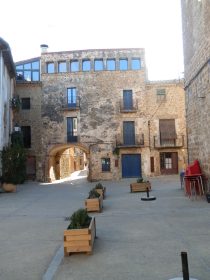 Some times going out for a walk you run into a happy accident. Though Rupia is just off the main route from Girona to Torroella and L'Estartit for us it's not on our normal route home so we rarely go past. And even if you do drive through it's easy just to miss the towns so this was a little bit of an explore for us, but one that turned up a couple of interesting towns/villages off the beaten track.
Some times going out for a walk you run into a happy accident. Though Rupia is just off the main route from Girona to Torroella and L'Estartit for us it's not on our normal route home so we rarely go past. And even if you do drive through it's easy just to miss the towns so this was a little bit of an explore for us, but one that turned up a couple of interesting towns/villages off the beaten track.
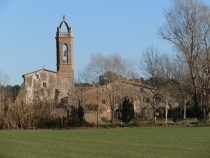 The walk started in Rupia. There's easy marked parking just outside the centre. Rupia is a small town with an inner square that, like many Empordan towns, is actually walled in by the surrounding houses for protection so you need to go into the centre to get a proper sense of the town. Consequently the first thing was to walk around the village to find out where everything was.
The walk started in Rupia. There's easy marked parking just outside the centre. Rupia is a small town with an inner square that, like many Empordan towns, is actually walled in by the surrounding houses for protection so you need to go into the centre to get a proper sense of the town. Consequently the first thing was to walk around the village to find out where everything was.
Having got locations we headed north out of the village back to the main road. The path follows a track marked as a bike path (the brown signs) on the right hand side of the bus stop and the right hand side of the hill in front of you. After a few hundred metres the path opens up to broad open field with views to Torroella in the distance to the right and up past Jafre to the north. The views are very clear at this time of year.
We walked along the track until the cross roads near the pretty, but strangely isolated, church of Santa Maria - that is it's an impressive church built near a masia farmhouse but with no apparent village nearby. The quirkily named village of Ultramort is just the other side of the hill with it's own church. At the cross-roads is a metal cross just as you reach the tarmacked road. Instead of taking the road we turned left and followed the track towards the castle of Foixa to your left.
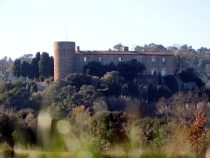
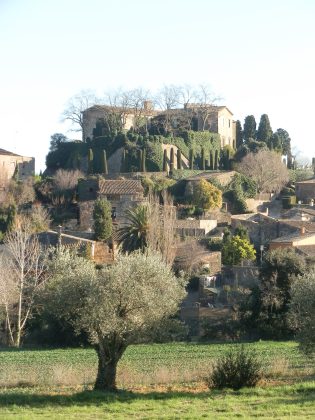 The castle is private and stands above the plain and following the track will take you all the way to the top. At the top take the chance to explore the small huddle of houses around the castle before following the path to the village of Foixa itself down to a stream and another cross - stone this time, before gently going up to the village itself. From the village road you have very clear views across the plain of the river Ter below and out to L'Estartit and the Isles Medes in the distance. And across the valley from the church are a number of sizeable old masias.
The castle is private and stands above the plain and following the track will take you all the way to the top. At the top take the chance to explore the small huddle of houses around the castle before following the path to the village of Foixa itself down to a stream and another cross - stone this time, before gently going up to the village itself. From the village road you have very clear views across the plain of the river Ter below and out to L'Estartit and the Isles Medes in the distance. And across the valley from the church are a number of sizeable old masias.
Being unfamiliar with the village we're not sure if we saw all of it, or the best of it, but we headed up through the centre until the road turned into a track through the woods and we followed the track through the woods. At the end of the track, the path met a tarmacked road. This was a little bit of a surprise as our map still had it as a footpath. The walk is a little dull along the road so there is probably a better route for next time. When we reached the Foixa-La Pera road a brief left followed by a right along by what looks like an airstrip and then over the top of the hill and back down to Rupia.
Crossing the main road again, the path follows a small stream back into Rupia itself.
Neighbouring walks: La Pera, Pubol and around - Serra de Daro, Fonolleres, Sant Iscle d'Emporda - Verges, Tallada d'Emporda and Maranya - Sant Jordi Desvalls, Colomers and Sant Llorenç de les Arenes
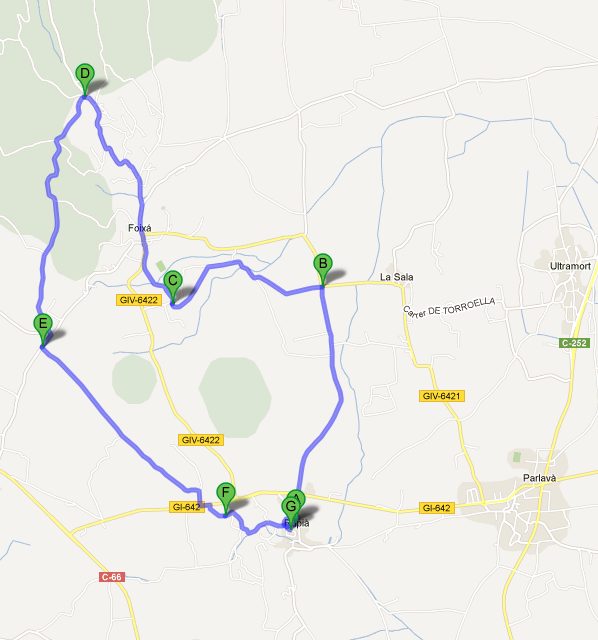
Gualta, Llabia, Fontanilles and the lake of Ullastret
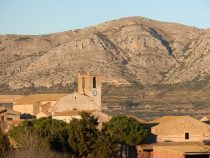 I've been looking at old maps and photographs of Emporda to get a sense of how the countryside has changed over time. Emporda is an ancient land - it was settled originally by Greeks, then came the Romans and after the Romans came Visigoths, Muslim invaders and then the Franks. Catalonia itself is one of the Spanish Marches - that is a body of land separating two opposing forces as a kind of buffer state. As a result it is a land which is full of castles and towers and fortified villages on top of hilltops.
I've been looking at old maps and photographs of Emporda to get a sense of how the countryside has changed over time. Emporda is an ancient land - it was settled originally by Greeks, then came the Romans and after the Romans came Visigoths, Muslim invaders and then the Franks. Catalonia itself is one of the Spanish Marches - that is a body of land separating two opposing forces as a kind of buffer state. As a result it is a land which is full of castles and towers and fortified villages on top of hilltops.
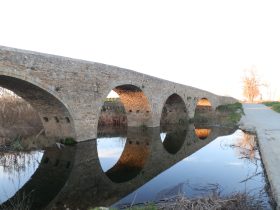 The other feature of Emporda is water. If you look at old maps you will see the coastline changes over time. For instance Pals was once on the sea and Torroella had access to the sea along the Ter. Over the centuries the lowlands and marshes at the mouth of the rivers Ter and Fluvia (and Muga higher up) have been drained and dried out. One intriguing feature on older maps, even to the early 20th century was that there were several inland lakes marked and routes and areas described as Estany - or lake in Catalan.
The other feature of Emporda is water. If you look at old maps you will see the coastline changes over time. For instance Pals was once on the sea and Torroella had access to the sea along the Ter. Over the centuries the lowlands and marshes at the mouth of the rivers Ter and Fluvia (and Muga higher up) have been drained and dried out. One intriguing feature on older maps, even to the early 20th century was that there were several inland lakes marked and routes and areas described as Estany - or lake in Catalan.
 One of the largest of these is the lake of Ullastret - a large (3km long) depression now completely emptied, but in the past a broad body of water between Ullastret (the Iberic village of Ullastret would have stood above the lake), and the hills of Llabia/Fontanilles on the other side. Reading the history, the lake itself was drained mechanically with a steam-engine taking about 30 year to pump out the water between the 1850s and 1880s. It would probably have been smelly in summer as it dries out - so locals were all in favour of drainage. Apparently in heavy rain parts of this lake can re-appear.
One of the largest of these is the lake of Ullastret - a large (3km long) depression now completely emptied, but in the past a broad body of water between Ullastret (the Iberic village of Ullastret would have stood above the lake), and the hills of Llabia/Fontanilles on the other side. Reading the history, the lake itself was drained mechanically with a steam-engine taking about 30 year to pump out the water between the 1850s and 1880s. It would probably have been smelly in summer as it dries out - so locals were all in favour of drainage. Apparently in heavy rain parts of this lake can re-appear.
 The walk starts at Gualta. There is parking near the old bridge over the Daro. The first part of the walk is on the road to reach Llabia - it means walking on tarmac, but the road is quiet with very little traffic. Llabia is a small village on a hill with broad views in all directions and particularly good views of the Pyrenees. We walked through the village and out the other end along the Carrer Major (like many 'main roads' in small old villages it isn't really 'major'). One of the streets you pass at the end of the village is Carrer d'Estany showing how the lake is captured in the place names.
The walk starts at Gualta. There is parking near the old bridge over the Daro. The first part of the walk is on the road to reach Llabia - it means walking on tarmac, but the road is quiet with very little traffic. Llabia is a small village on a hill with broad views in all directions and particularly good views of the Pyrenees. We walked through the village and out the other end along the Carrer Major (like many 'main roads' in small old villages it isn't really 'major'). One of the streets you pass at the end of the village is Carrer d'Estany showing how the lake is captured in the place names.
Continue out and Carrer Major turns into a gravel track with what would have been the lake to the right. The lake bed is now a collection of what look like very fertile fields beneath you and across the 'lake' extremely clear views to the mountains. On the other side of the lake you should be able to make out the village of Ullastret and the museum building for the Iberic village.
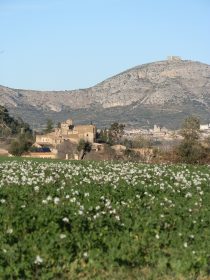 The road continues south past olive groves to a cross roads at the end of the hill on your left. Turn to the left and follow the path to Fontanilles. Fontanilles is actually on the GR92 and looks over the bay of Pals. The village is a little bit tumbledown and unkempt. For me this is less pretty than the view across the lake on the other side of the hill so if you are walking the GR92, you might consider a diversion. Nonetheless, the path from Fontanilles climbs up the hill past the cemetary. At the top is a viewpoint with views to the south to Pals and Palafrugell and to Torroella and the Isles Medes to the north-east.
The road continues south past olive groves to a cross roads at the end of the hill on your left. Turn to the left and follow the path to Fontanilles. Fontanilles is actually on the GR92 and looks over the bay of Pals. The village is a little bit tumbledown and unkempt. For me this is less pretty than the view across the lake on the other side of the hill so if you are walking the GR92, you might consider a diversion. Nonetheless, the path from Fontanilles climbs up the hill past the cemetary. At the top is a viewpoint with views to the south to Pals and Palafrugell and to Torroella and the Isles Medes to the north-east.
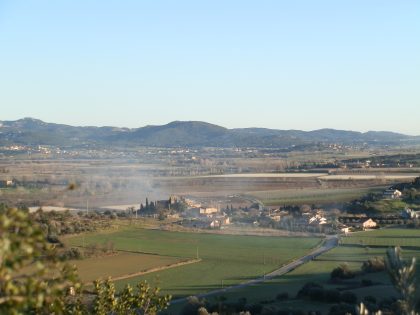 Follow the path down the hill and then turn to the right to get to Gualta. The village has a character to it without necessarily being particularly photogenic. Before the church is an old mill with water conduits that would be used to control the water entering into the bay of Pals. Pals has a large and complex system of irrigation for the rice paddies with water coming from the Daro (via Gualta) and the Ter. Continue past the church and back to the old bridge. You can see the tracks worn by the carts as they crossed the bridge to get to the Torroella road.
Follow the path down the hill and then turn to the right to get to Gualta. The village has a character to it without necessarily being particularly photogenic. Before the church is an old mill with water conduits that would be used to control the water entering into the bay of Pals. Pals has a large and complex system of irrigation for the rice paddies with water coming from the Daro (via Gualta) and the Ter. Continue past the church and back to the old bridge. You can see the tracks worn by the carts as they crossed the bridge to get to the Torroella road.
Neighbouring walks: Canapost, Poblet Iberic and Ullastret - Palau-sator and Peratallada - Torroella de Montgri castle - Serra de Daro, Fonolleres, Sant Iscle d'Emporda - Torroella de Montgri to Gola de Ter - Evening walk Pals to Sant Feliu de Boada
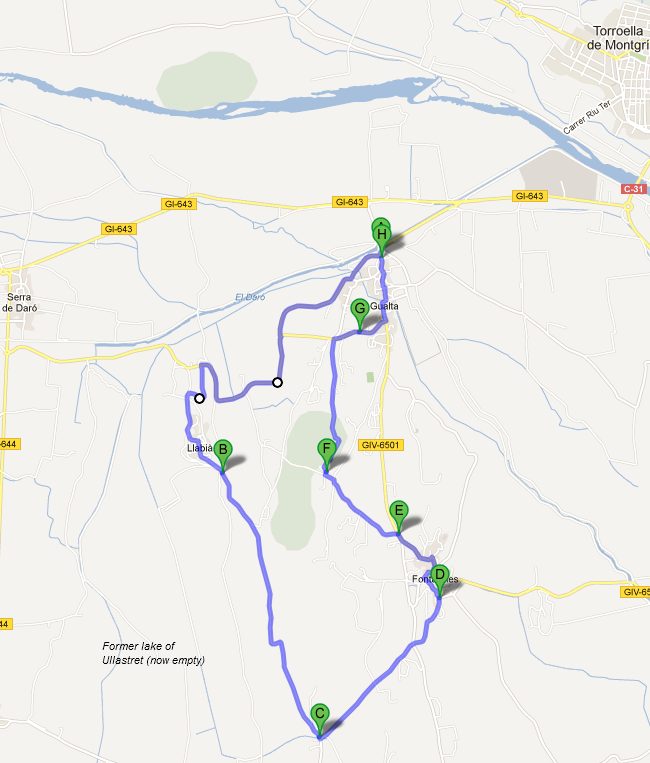
St Pol de Bisbal and Santa Lucia
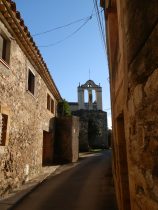 On the walk around and through La Bisbal I had the aim of reaching the hamlet of St Pol but not having a map with me I didn't quite reach the village. So a few days later we went back to find St Pol and walk in the woods to Santa Lucia del Bosque.
On the walk around and through La Bisbal I had the aim of reaching the hamlet of St Pol but not having a map with me I didn't quite reach the village. So a few days later we went back to find St Pol and walk in the woods to Santa Lucia del Bosque.
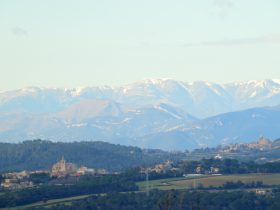 St Pol is a small hamlet (about 10 houses) with a small church just outside La Bisbal in the direction of the Gavarres and Calonge. The main street is quite narrown, but there is parking just next to the church. The village itself appears on old maps, though now it is relatively isolated with one drivable road in and out, and it is connected to the GR92 coastal path network which is also usually a good sign.
St Pol is a small hamlet (about 10 houses) with a small church just outside La Bisbal in the direction of the Gavarres and Calonge. The main street is quite narrown, but there is parking just next to the church. The village itself appears on old maps, though now it is relatively isolated with one drivable road in and out, and it is connected to the GR92 coastal path network which is also usually a good sign.
From the church we followed the road out of the village and up into the woods. At a T junction we followed the road to the left (not the GR92 route) towards Santa Lucia del Bosque. This is actually a drivable track and provides access into the masias in the hills. The path is pleasant with views over Cruilles and to the Pyrenees in the distance, though it is largely a typical wood trial. About three quarters of the way along, an signpost indicates a split - a small walking track to the right or the main road. We followed the track down into the valley and then out up the other side through the woods. At the other side another sign points to the Font de Santa Lucia - a small fountain with drinking water, then it's a rough climb following the path up to the chapel of Santa Lucia at the top.
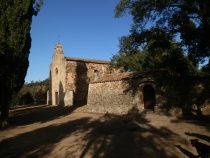 Again, avoiding the GR92 we followed the main drivable track past the chapel and back down into the valley then up the other side to the large masia that stands over the valley. Climbing up and then past the masia, we took the next lefthand path around to the next valley (note there is a signpost 50m ahead of you for a different path - we didn't take or reach the signposted path).
Again, avoiding the GR92 we followed the main drivable track past the chapel and back down into the valley then up the other side to the large masia that stands over the valley. Climbing up and then past the masia, we took the next lefthand path around to the next valley (note there is a signpost 50m ahead of you for a different path - we didn't take or reach the signposted path).
The track curves around the valley head giving views across the plain, then turns to the left and along back out to the St Pol village.
Neighbouring walks: La Bisbal, Vulpellac, Castell d'Emporda, Fonteta - Cruilles, Monells and Sant Sadurni de l'Heura - Madremanya, Els Angels, Sant Marti Vell
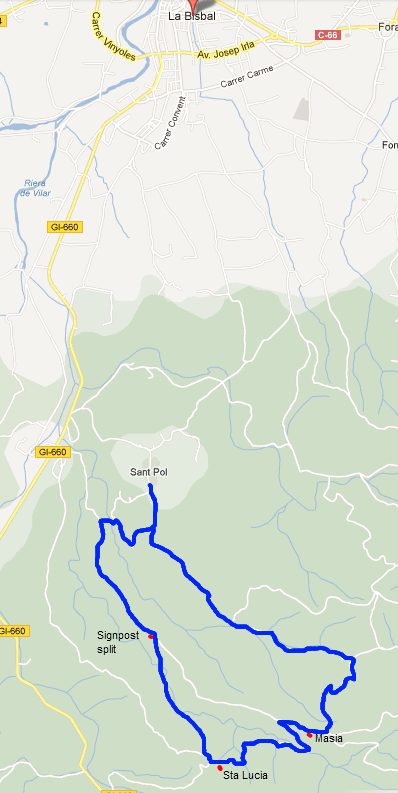
Mont-ras 'boar' walk
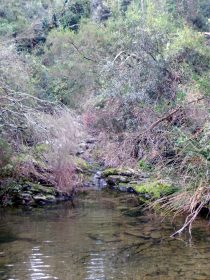 Mont-ras is our neighbourhood, so we start and finish a lot of walks in the village. Fortunately there is a wide variety of walks available with lots of different paths - we can go up into the Gavarres or out across the plain towards the sea or the towns. As a result we pretty much walk in the Gavarres two or three times a week and we're still finding new routes.
Mont-ras is our neighbourhood, so we start and finish a lot of walks in the village. Fortunately there is a wide variety of walks available with lots of different paths - we can go up into the Gavarres or out across the plain towards the sea or the towns. As a result we pretty much walk in the Gavarres two or three times a week and we're still finding new routes.
One of the things we've found is that there are a lot of tracks and smaller routes in the hills that aren't actually marked on the maps. The tracks aren't just used by walkers - there is a great deal of mountain biking through the woods.
The main walk on the maps is a round trip circling Puig Cucala - a hill with an electricity pylon right on top (with great views, but it's a steep and rough climb up and down to the top). This 'recommended' route is a fairly decent Sunday afternoon stroll up into the hills with views to the sea on broad paths.
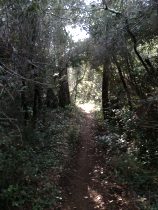 The following walk is a more interesting variation taking you down through the woods on a smaller more wooded path, criss-crossing a small stream. Unfortunately wooded paths don't really photograph well - it just looks like a path in the woods - so you'll have to try it to see why we like it.
The following walk is a more interesting variation taking you down through the woods on a smaller more wooded path, criss-crossing a small stream. Unfortunately wooded paths don't really photograph well - it just looks like a path in the woods - so you'll have to try it to see why we like it.
We used to call it the frog walk because towards the bottom the stream forms a pool of water and on one occasion in spring we walked past to the loud singing of a full blown frog chorus.
It got renamed in the summer when our dog got spooked by loud rustling in the undergrowth and the appearance of wild boar tracks. We didn't see anything but are pretty sure the boars (senglars in Catalan) were rooting about in the undergrowth.
In summer the senglars have litters of young and you are warned not to get too close as the parents (who are normally shy) can get aggressive to protect their young. There is also no hunting allowed during this period.
In the winter the hunting season starts again and many of the tracks are used by hunters looking for the animals.
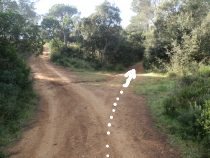 The walk starts from Mont-ras church and heads up to the top of the hill. There are a number of routes up. In this case we take Carrer Major into the woods, but almost immediately turn left and head up the hill past the top two houses of the village.
The walk starts from Mont-ras church and heads up to the top of the hill. There are a number of routes up. In this case we take Carrer Major into the woods, but almost immediately turn left and head up the hill past the top two houses of the village.
Keep going up until the path flattens out right at the top. You'll pass a field on your left and the path splits.
Take the left hand path around the field. This meets the next path at a T junction.
Take the left path (part of the Puig Cucala route) past the red and yellow stripped water indicator and Bosch de Dalt house.
In front of you the path splits. Instead of following the main Puig Cucala route, take the right had split into the woods of the next valley. This path runs down to a clearing that looks out over the sea through the trees.
The path continues past the clearing and you just head down into the valley - there are a few spur paths, but basically you keep left and head down.
Some of the path gets rocky and then suddenly you're on a narrow muddy footpath towards the base of the valley. As you walk you'll find yourself following a small stream and the way the path goes (still keep to your left) you'll cross the stream about three or five times. The frog pool is down towards the bottom.
At the end you emerge at a broad track road and follow the path towards the houses of the Molines urbanisation. Again keep to the left and follow the road back through the older part of the Mont-ras village.
Neighbouring walks: Mont-ras to Calella de Palafrugell and Llafranc - Mont-ras Fountain walk - Llofriu, St Llop and Torrent - Eulogy to the Ruta del Tren Petit (Palafrugell, Palamos, Mont-ras and Vall-llobrega) - Mont-ras to Fitor and on to Fonteta and Vulpellac
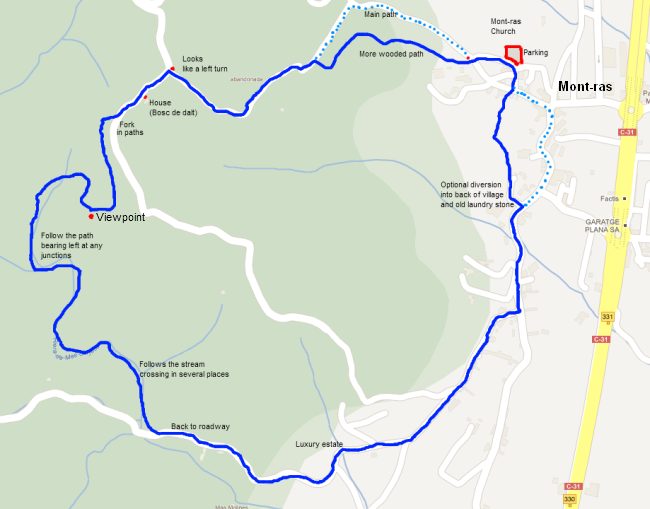
La Bisbal, Vulpellac, Castell d'Emporda, Fonteta
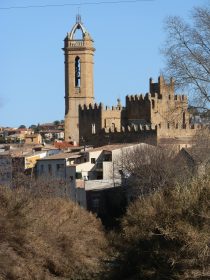 La Bisbal d'Emporda is the principle town of Baix Emporda and former seat of the Bishops of Girona. Situated inland, when you drive through for the first time it's easy to think of the town as just one long stream of ceramics/pottery shops on the way to the coast. In many ways this view comes because the main through-route for the town (linking Girona to Palamos) runs perpendicular to the main interest/historic axis. If you stopped in the centre where the road crosses the river Daro and went along the river either to your left or to your right you would have a completely different view of the town. La Bisbal was an important religious and political centre which is reflected not just in the town, but in the villages around.
La Bisbal d'Emporda is the principle town of Baix Emporda and former seat of the Bishops of Girona. Situated inland, when you drive through for the first time it's easy to think of the town as just one long stream of ceramics/pottery shops on the way to the coast. In many ways this view comes because the main through-route for the town (linking Girona to Palamos) runs perpendicular to the main interest/historic axis. If you stopped in the centre where the road crosses the river Daro and went along the river either to your left or to your right you would have a completely different view of the town. La Bisbal was an important religious and political centre which is reflected not just in the town, but in the villages around.
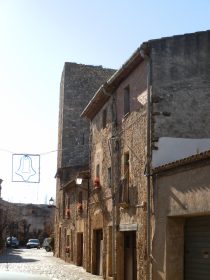 The walk itself starts in the village of Vulpellac just outside La Bisbal. This is a historic medieval village complete with small castle by the church and stone houses that are found in all the villages around La Bisbal. There is plenty of parking just off the roundabout at the entrance to the village. We walk through the village and out the other side, then into the fields along a track. A Tramuntana wind was whipping through the vale on this particular day. The Tramuntana is the northly wind that blows down from the Pyrenees to the coast and so can be quite cold (the southerly wind that blows cool off the sea in the summer is the Garbi). However, it also clears the air and in winter gives fabulous visability.
The walk itself starts in the village of Vulpellac just outside La Bisbal. This is a historic medieval village complete with small castle by the church and stone houses that are found in all the villages around La Bisbal. There is plenty of parking just off the roundabout at the entrance to the village. We walk through the village and out the other side, then into the fields along a track. A Tramuntana wind was whipping through the vale on this particular day. The Tramuntana is the northly wind that blows down from the Pyrenees to the coast and so can be quite cold (the southerly wind that blows cool off the sea in the summer is the Garbi). However, it also clears the air and in winter gives fabulous visability.
 After a while the path turns up towards the woods and we follow a track to the top of the hill. The hill itself is like a finger pointing out from La Bisbal so there are views on either side. At the top you reach the first row of houses of La Bisbal, but instead of going into the town, turn to the right and keep along the top of the finger. After about 200m you should see a sports club below the path and the first views out to the mountains. In this particular case the Tramuntana had also left a little more snow on the peaks so not only was the view extremely clear, the mountains were also shrouded in white. Keep along the ridge until you see a set of gates below you. The path curves down to the gates. This marks the entrance to Castell d'Emporda.
After a while the path turns up towards the woods and we follow a track to the top of the hill. The hill itself is like a finger pointing out from La Bisbal so there are views on either side. At the top you reach the first row of houses of La Bisbal, but instead of going into the town, turn to the right and keep along the top of the finger. After about 200m you should see a sports club below the path and the first views out to the mountains. In this particular case the Tramuntana had also left a little more snow on the peaks so not only was the view extremely clear, the mountains were also shrouded in white. Keep along the ridge until you see a set of gates below you. The path curves down to the gates. This marks the entrance to Castell d'Emporda.
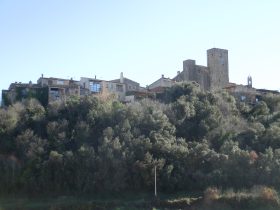 Castell d'Emporda itself sits on the end of the finger giving it a broad sweep of a view over the lands to the north and west. The castle itself has been turned into a luxury hotel, but retains the original building as it's centrepiece. Follow the road below the castle and turn to the left along the street with the no entry sign marked viens (neighbours) - we're walking so it doesn't apply. You find yourself in a narrow street of old houses that would have been the original hamlet for the castle. On old maps Castell d'Emporda is marked as a distinct place - it is not bound up with La Bisbal. Walk down the street and at the bottom turn left and the path takes you down off the finger to the fields below.
Castell d'Emporda itself sits on the end of the finger giving it a broad sweep of a view over the lands to the north and west. The castle itself has been turned into a luxury hotel, but retains the original building as it's centrepiece. Follow the road below the castle and turn to the left along the street with the no entry sign marked viens (neighbours) - we're walking so it doesn't apply. You find yourself in a narrow street of old houses that would have been the original hamlet for the castle. On old maps Castell d'Emporda is marked as a distinct place - it is not bound up with La Bisbal. Walk down the street and at the bottom turn left and the path takes you down off the finger to the fields below.
 At the bottom double back slightly to get to a track to cross the fields in order to reach the path that runs along by the river Daro. Although the riverbed is broad, in practice the Daro is an occasional river. Unlike the neighbouring Ter or Fluvia which take their water from the Pyrenees, the Daro rises in the Gavarres so in winter there will often be a steady flow of water, in summer the river can be dry (in Catalan there is a distinction between a Riu - a river that runs all year round, and a Riera which is a river that is dry in summer; there is also a Torrent which is a river that flows only after a downpour).
At the bottom double back slightly to get to a track to cross the fields in order to reach the path that runs along by the river Daro. Although the riverbed is broad, in practice the Daro is an occasional river. Unlike the neighbouring Ter or Fluvia which take their water from the Pyrenees, the Daro rises in the Gavarres so in winter there will often be a steady flow of water, in summer the river can be dry (in Catalan there is a distinction between a Riu - a river that runs all year round, and a Riera which is a river that is dry in summer; there is also a Torrent which is a river that flows only after a downpour).
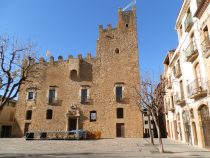 We follow the river along the riverbank. On the other side of the river are ceramics factories and across the view of the town ahead there are the occasional high chimneys, remnants of La Bisbal's most important industry. Although the industry has declined relatively speaking, there are still a number of potteries in La Bisbal and the town also has a Terracota museum. Most of the clay is dug in pits on other side of the town, but you would really have to know where to go to be able to see them.
We follow the river along the riverbank. On the other side of the river are ceramics factories and across the view of the town ahead there are the occasional high chimneys, remnants of La Bisbal's most important industry. Although the industry has declined relatively speaking, there are still a number of potteries in La Bisbal and the town also has a Terracota museum. Most of the clay is dug in pits on other side of the town, but you would really have to know where to go to be able to see them.
The first view of La Bisbal will also give you a view of the main church but also one of the most ill-placed blocks of flats on the Costa Brava - a great bleugh of a building that is both too high (by about eight floors) and terribly placed sitting right in the centre of the town. You can't help but see it and it ruins the skyline and dominates over the more interesting and important historic buildings in La Bisbal. Unfortunately the building craze in the 60s and 70s left a few of these monstrosities across the Costa Brava. Fortunately building standards in the 1980s and onwards have much better protected the townscapes.
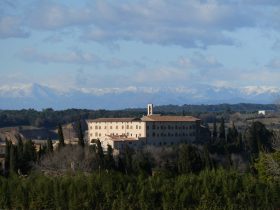 We follow the path into the centre of town. You can take the path on either side along an avenue of plain trees. It's worth exploring the centre a little. The old centre is to the left as you walk towards it but you might want to keep to the right then cross the Daro at the ancient stone footbridge. Ahead of you is one of the old town gates and going through the gate is a networks of small streets, arches and small squares. On market days (Fridays) the whole centre seems crammed full of stalls selling produce, clothes and almost anything else you can think of. You will also find the old palace-castle of La Bisbal - former residence of the archbishops of Girona (La Bisbal means bishop).
We follow the path into the centre of town. You can take the path on either side along an avenue of plain trees. It's worth exploring the centre a little. The old centre is to the left as you walk towards it but you might want to keep to the right then cross the Daro at the ancient stone footbridge. Ahead of you is one of the old town gates and going through the gate is a networks of small streets, arches and small squares. On market days (Fridays) the whole centre seems crammed full of stalls selling produce, clothes and almost anything else you can think of. You will also find the old palace-castle of La Bisbal - former residence of the archbishops of Girona (La Bisbal means bishop).
After looking around the centre cross the river at the stone bridge once more and continue along the footpath following the river upstream and out of town. Cross the main bypass (it's not too busy) into fields and then cross the river again at the next ford. Even if the river has water there is normally a dry crossing possible. This takes you into an older part near the open-air swimming pool. Continue walking along the river past the swimming pool and out of the town. At the next junction go left. Cross the road and head into the fields. The aim is to circumnavigate the town from the back.
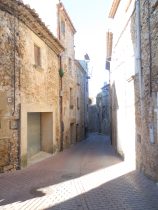 On the hill you'll see the Convent standing proud. As Bisbal is a former religious centre the convent is large and dominates the space around it. Some of the older streets and more interesting historic places are those that link the convent to the main town centre. Technically, I had the aim of trying to reach St Pol - a small hamlet a little further on, but I neglected to take a map and found I couldn't connect the paths to reach the village. So in this case we follow the footpath around the back of the convent. You'll find signposts and we follow them to Fonteta.
On the hill you'll see the Convent standing proud. As Bisbal is a former religious centre the convent is large and dominates the space around it. Some of the older streets and more interesting historic places are those that link the convent to the main town centre. Technically, I had the aim of trying to reach St Pol - a small hamlet a little further on, but I neglected to take a map and found I couldn't connect the paths to reach the village. So in this case we follow the footpath around the back of the convent. You'll find signposts and we follow them to Fonteta.
Fonteta is another small village that winds up a slight incline towards the entrance to the Fitor road on top of the Gavarres. From Fonteta, it is a flat walk back around to Vulpellac.
Neighbouring walks: Canapost, Poblet Iberic and Ullastret -Corça, Casavells, Matajudaica - Clots de Sant Julia (Vulpellac) - St Pol de Bisbal and Santa Lucia - Cruilles, Monells and Sant Sadurni de l'Heura - Monells and Mont-negre - Palau-sator and Peratallada - Mont-ras to Fitor and on to Fonteta and Vulpellac - Madremanya, Els Angels, Sant Marti Vell - Canapost to the medieval fair at Peratallada
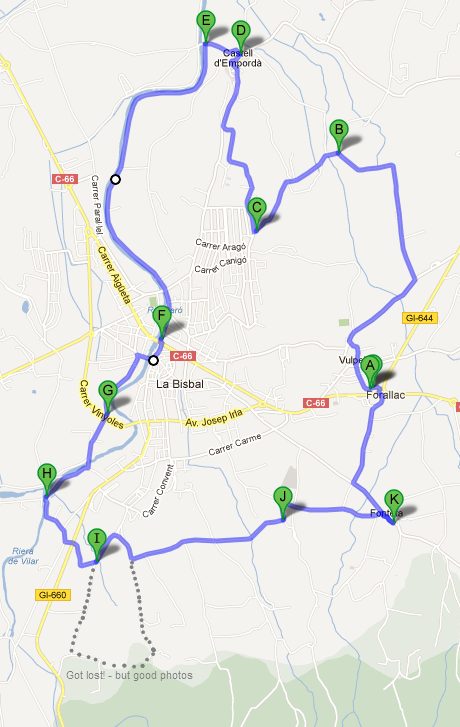
Regencos to Pals via Quermany Gros and Petit
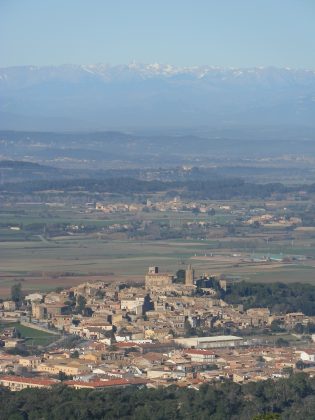 Pals is the most famous inland village on the Costa Brava, often frequented by coach trips from the bigger resorts like Tossa or Llorett to the south. The village is medieval and stands on a low isolated hill surrounded by levels (used for growing rice) and consequently stands proud above the surrounding countryside.
Pals is the most famous inland village on the Costa Brava, often frequented by coach trips from the bigger resorts like Tossa or Llorett to the south. The village is medieval and stands on a low isolated hill surrounded by levels (used for growing rice) and consequently stands proud above the surrounding countryside.
The village itself is a collection of narrow streets and arches that wind their way to the church and lookout tower at the top of the town. There are quite a few recommended restaurants in the town and nearby and every year Pals holds a festival de arros (rice festival). The levels around the town come about because at least until the middle ages, much of the surrounding area was either sea, or a sea-etang/marsh area. These have been drained, or the sea has receded, to leave rich fertile flat plains with plenty of available water from the river Ter.
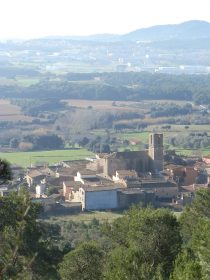 This walk starts in Regencos. Regencos is also an old village of about 50-100 houses and a church. Most people would follow the road as it bypasses the village heading towards Begur and never stop in Regencos itself. Behind Regencos is a small hill called Quermany (pronounced Querman) which is only about 220 metres high, but because of it's position above the levels gives fabulous views up and down the coast and out to the Pyrenees.
This walk starts in Regencos. Regencos is also an old village of about 50-100 houses and a church. Most people would follow the road as it bypasses the village heading towards Begur and never stop in Regencos itself. Behind Regencos is a small hill called Quermany (pronounced Querman) which is only about 220 metres high, but because of it's position above the levels gives fabulous views up and down the coast and out to the Pyrenees.
There is parking in Regencos, then it is a simple walk following the obvious track up the hill to the top of Quermany Gros. The path splits at the water-deposit and you take the left fork onto a smaller path that winds you around the hill to the top.
The path itself is not special (and on the way down will be rocky so it needs good footwear), but as you start to reach the top, the landscape around starts to unfold to give great views towards Begur, then the Isles Medes and up to Roses/Cap Creus, then across to Torroella and Montgris. Then Pals and the villages of Peretallada, Palau-sator and Torrent and out to the mountains, and looking south across Palafrugell to the high-rises of Palamos and St Antoni de Calonge. All of the photos here were taken on the walk from the various viewpoints available.
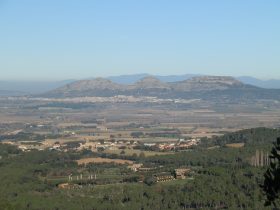 Once you've finished admiring the many views from Quermany Gros it's time to continue onwards. Below you, towards Pals, is another hill - this is Quermany Petit. As you head down follow the path signposted towards Pals. There are quite a few routes on the way down so diversions are possible, but it's also easy to take the wrong path and end up behind rather than in front of Quermany Petit. The route we took went to the left and then down to the campsite. As you pass the campsite - almost at the campsite edge with caravans below you - a path heads back up to the right. This takes you to Quermany Petit.
Once you've finished admiring the many views from Quermany Gros it's time to continue onwards. Below you, towards Pals, is another hill - this is Quermany Petit. As you head down follow the path signposted towards Pals. There are quite a few routes on the way down so diversions are possible, but it's also easy to take the wrong path and end up behind rather than in front of Quermany Petit. The route we took went to the left and then down to the campsite. As you pass the campsite - almost at the campsite edge with caravans below you - a path heads back up to the right. This takes you to Quermany Petit.
The reason for going to Quermany Petit is because this gives the best view of Pals. If you judge the day right you get Pals standing off the plain with the snow on the Pyrenees directly behind the village.
The path off Quermany Petit actually ends at the main roundabout on the way in to Pals village. This can be quite busy to cross. An alternative is to follow the path by the farm to the right which will wind around a little more until it meets a road that passes under the main Pals bypass and saves crossing the road.
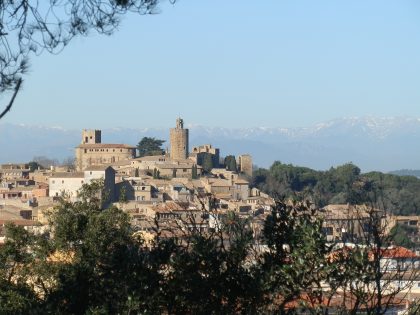 Obviously you can also stop and visit Pals, but on this occasion we carried on with the walk. To the south of the village is a broad gravel track which is used as a bike path (marked with brown signposts). It's an easy flat cycle if you want to explore the neighbouring villages. We follow the signpost directions towards Palafrugell which takes us down to the main Torrent-Pals road by the waterworks. This is also busy so care is needed crossing. On the other side you pass open fields and a couple of pig farms before turning towards a farm and a cross-roads. At the cross-roads Regencos will be sign posted and you can walk back to the village.
Obviously you can also stop and visit Pals, but on this occasion we carried on with the walk. To the south of the village is a broad gravel track which is used as a bike path (marked with brown signposts). It's an easy flat cycle if you want to explore the neighbouring villages. We follow the signpost directions towards Palafrugell which takes us down to the main Torrent-Pals road by the waterworks. This is also busy so care is needed crossing. On the other side you pass open fields and a couple of pig farms before turning towards a farm and a cross-roads. At the cross-roads Regencos will be sign posted and you can walk back to the village.
Neighbouring walks:Masos de Pals, Begur, Sa Riera and Platja de Pals - Evening walk Pals to Sant Feliu de Boada - Palafrugell, Tamariu, Begur residential and Esclanya - Llofriu, St Llop and Torrent - Pals beach to Gola de Ter
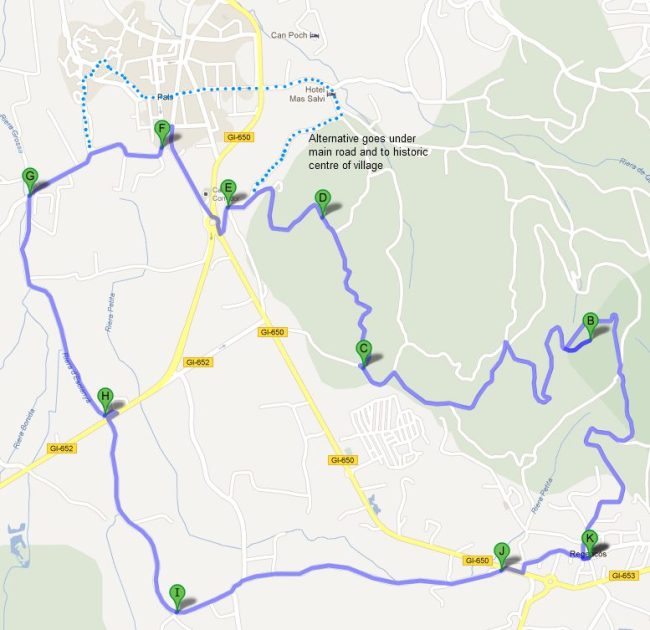
Pals beach to Gola de Ter
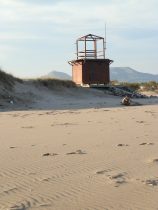 Platja de Pals is a huge long beach that stretches for several kilometres from the main holiday urbanisation past Masos de Pals and all the way up to L'Estartit and the Isles Medes in the north. From the southern part of the beach you can reach the hidden Platja del Roca beach and round to Sa Riera which is technically part of Begur.
Platja de Pals is a huge long beach that stretches for several kilometres from the main holiday urbanisation past Masos de Pals and all the way up to L'Estartit and the Isles Medes in the north. From the southern part of the beach you can reach the hidden Platja del Roca beach and round to Sa Riera which is technically part of Begur.
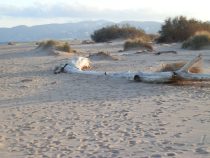 The beach itself is the basin for the outflow of the river Ter. Away from the two ends it's quite flat and in the Middle Ages when sea levels were higher much of this area is marked as being a large sea lake. Now the same flat fields and wide availability of water means it is a prime rice growing area full of rice paddies. Until the mid 2000s, the beach itself was the location of a number of very large radio masts used for broadcasting propaganda into Russia. These have been dismantled giving much of the beach a wild natural feeling.
The beach itself is the basin for the outflow of the river Ter. Away from the two ends it's quite flat and in the Middle Ages when sea levels were higher much of this area is marked as being a large sea lake. Now the same flat fields and wide availability of water means it is a prime rice growing area full of rice paddies. Until the mid 2000s, the beach itself was the location of a number of very large radio masts used for broadcasting propaganda into Russia. These have been dismantled giving much of the beach a wild natural feeling.
We walked this in winter which is the best time of the year for beach combing. Drift wood washes up on the sand and the wind half buries it leaving spooky white branches reaching out of the sand. Along the edge of the beach are dunes and sand grasses and people are far and few between.
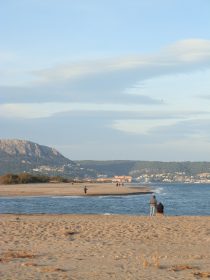 There are really two options for the walk. You can start at the bottom by the main Platja de Pals restaurants (usually shut up in winter), and then have an extra long walk, or you can short-circuit it and start higher up the beach by the Green Dolphin Campsite (Delfin Verde). Since this is pretty much an up and back type of walk we tend to start at the Delfin Verde.
There are really two options for the walk. You can start at the bottom by the main Platja de Pals restaurants (usually shut up in winter), and then have an extra long walk, or you can short-circuit it and start higher up the beach by the Green Dolphin Campsite (Delfin Verde). Since this is pretty much an up and back type of walk we tend to start at the Delfin Verde.
The walk is easy. Head north towards L'Estarit. The sand isn't too soft to walk on and our dog just loves the freedom of running on the sand (ok in winter, not ok in summer). If it's windy you might find kite surfers on the sea. On a clear day the Isles Medes and Torroella de Montgri will be clear to see. Eventually you reach the Gola de Ter - the mouth of the river Ter as it cuts across the beach to reach the sea. Behind the mouth a huge fresh water lake builds up in winter often with reeds and birds.
Unfortunately you can't cross the Gola without getting wet. In summer when the river is lower you can swim across - it's only a few metres wide. In winter it's too cold and that bit wider.
Of course another option is to start at L'Estartit - that would be another walk though.
Neighbouring walks: Masos de Pals, Begur, Sa Riera and Platja de Pals - Torroella de Montgri castle - Torroella de Montgri to Gola de Ter - L'Estartit to Cala Pedrosa and Cala Ferriol - Sa Tuna, Cap de Begur, Begur
Swimming: Swimming at Gola del Ter (Pals/L'Estartit) or L'Estartit
Swimming at Platja de Pals and Platja Illa Roja
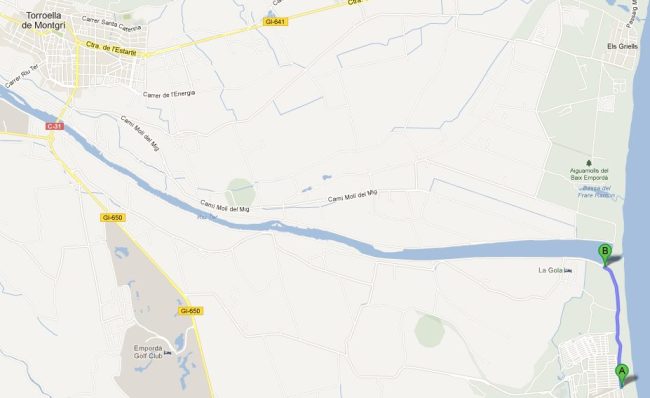
Mont-ras Fountain walk
 Mont-ras is our local neighbourhood so we do a lot of walking from here. One of the things we really enjoy is the variety of walking - one day we can be walking through the fields and farm land, the next up in to the Gaverres in what feels like total isolation.
Mont-ras is our local neighbourhood so we do a lot of walking from here. One of the things we really enjoy is the variety of walking - one day we can be walking through the fields and farm land, the next up in to the Gaverres in what feels like total isolation.
The area behind Mont-ras up into the hills is effectively a protected park - (a space of special natural interest). It broadly consists of wooded valleys that wrap around the hills. As you go higher you get a view out to the sea and across the Empordan villages below.
The woods themselves are used for mountain biking and hiking, and there are isolated Casitas among the trees, and on the top towards Fitor there are a handful of very large scattered old masia farms and open fields.
The way the valleys fold means it's relatively easy to find yourself in almost total isolation in the middle of nature.
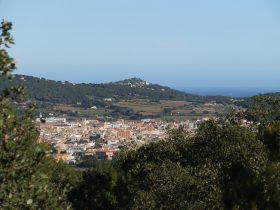 The walks and paths themselves aren't particularly well marked on maps. The maps tend to show the larger routes suitable for 4x4s or mountain bikes, but there are many other smaller tracks for walking that link across these paths - and are relatively well used by walkers, forestry or people out hunting.
The walks and paths themselves aren't particularly well marked on maps. The maps tend to show the larger routes suitable for 4x4s or mountain bikes, but there are many other smaller tracks for walking that link across these paths - and are relatively well used by walkers, forestry or people out hunting.
Although it is possible to feel lost on the small tracks, in practice it is difficult to get completely lost. At some point you hit a larger route and can always find your way down to civilisation.
The paths themselves vary and one path may go from soft sand one minute to rocks the next. Broadly most paths will be a mixture of sand and rock so it's worth having shoes with proper soles.
You won't find the soft peaty-type paths that you typically find in UK woods so it can be harder under foot. The paths can climb and drop but are always walkable (so no scrambling or steeper climbs).
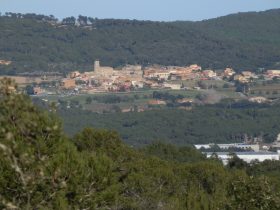 This walk we call the fountain walk because it runs down to Font de la Teula - a fountain spring in the middle of the woods. It doesn't appear on the general maps but is easy to find and to follow with a variety of options for short- or long-cuts. In particular you can use it as one route to Llofriu, the next village around.
This walk we call the fountain walk because it runs down to Font de la Teula - a fountain spring in the middle of the woods. It doesn't appear on the general maps but is easy to find and to follow with a variety of options for short- or long-cuts. In particular you can use it as one route to Llofriu, the next village around.
We start at Mont-ras church. There's a car park next-door, or if you prefer there's more parking (and a bar to come back to) down by the roundabout over the C31.
The path heads up and bears to the right to a sandy track called Carrer Major (to which someone has added an exclamation mark as it doesn't really look like the main street).
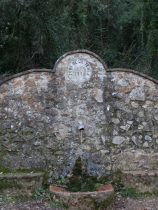 Follow the main path - after about 2-300 metres it forks near some beehives - the shorter, steeper route is to the left, and meets the straight on route higher up.
Follow the main path - after about 2-300 metres it forks near some beehives - the shorter, steeper route is to the left, and meets the straight on route higher up.
Basically you want to always be heading upwards. Towards the top the path becomes flatter and sandy - keep going straight with views over Palafrugell and Regencos to your right and you'll reach the 'Col de la Boqueta'. This is a confluence of several paths one of which is the main double-width sand track for cars driving up to Fitor at the saddle-point as the road passes from one side to the next.
Follow the double track as it goes upwards gently. After about 50m to the right a (currently fallen down) signpost marks the direction to the Mont-ras Mirador - a viewpoint over the plain below.
Continue along the road a little further. You should see another signpost on the lefthand side of the road with a wonky pointer.
On the opposite side of the road (to the right) is a track running into the woods. This track to the right is the one to follow.
Although flat initially it quickly starts to run down a valley - where you come to junctions keep bearing left. The path runs through a couple of high sided gulleys where water has lowered the path level relative to the ground and the gulley walls are now more than a metre high.
The path runs down through the woods until it reaches the Fountain (Font de la Teula) at the bottom.
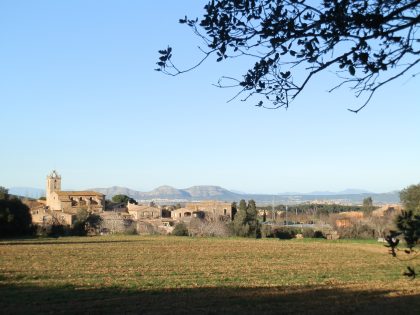 From here there are two options.
From here there are two options.
The route to the right broadly brings you back to Mont-ras via La Pedrera - a former quarry now picnic site.
The route to the left goes deeper into the woods. You can follow this path for a long way if you wish and it would eventually curve around to run back towards the Col de Tramuntana and Mas Torroella one of the farm houses at the top of the hill that is reached by the double-track road. This would be a long route, so the first time you see a left turn (almost seeming to go back), follow it and this will eventually take you out towards Llofriu.
As the track leaves the woods, it splits in two - the left side runs past a large imposing Masia (Roma) and then on into Llofriu itself. The right side is on the other side of the stream and will take you around the back of the village.
Llofriu itself is very pretty being a bundle of old houses around the church and stream. It's off the main road and the only way in or out by car is the one road.
Along from the old village are a collection of houses actually on the main Bisbal-Palafrugell road with three restaurants that always seem popular.
Assuming you take the right-hand track like the map, follow this until it meets another main looking road. At this point you turn right, again almost back on yourself, towards the farms.
Follow this path past the farms (the fields often have donkeys). When you see the rusty windmill/pump where the path splits, take the left path back into the woods. You can then follow the path along and past the Pedrera picnic site and back into Mont-ras.
Neighbouring walks: Mont-ras 'boar' walk - Llofriu, St Llop and Torrent - Mont-ras to Calella de Palafrugell and Llafranc - Mont-ras to Fitor and on to Fonteta and Vulpellac
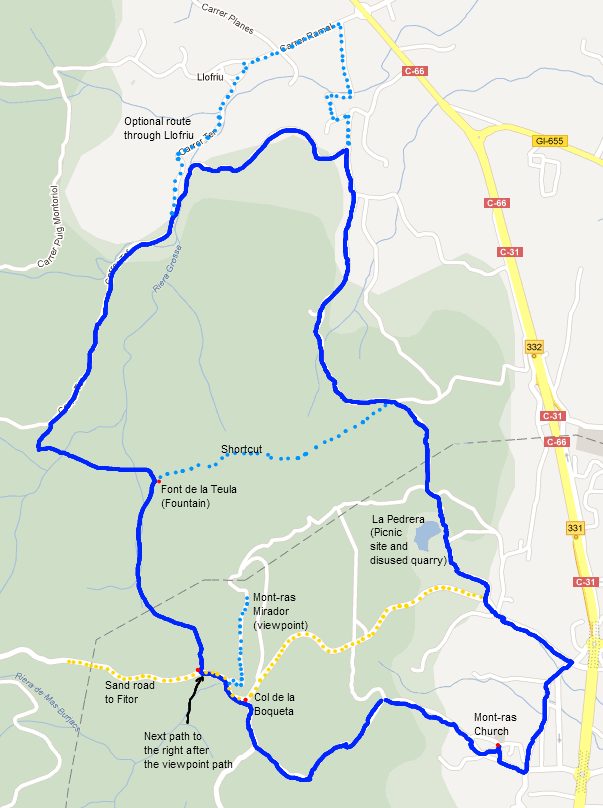
Comments | ||
adam@veggingoutwithadam.com |
17 Feb 2014 19:46 |
|
What a great blog. I am planning a walking holiday in the region and wonder if you can recommend the best walking maps, like UK ordnance survey ones. I shall be reading more of your walks over the coming days as we plan. Many thanks Adam | ||
Saul |
24 Feb 2014 17:25 |
|
Glad you're enjoying it. We have recommendations for maps in our 'Advice and FAQ' section | ||
Saul |
13 Jul 2017 12:46 |
|
Sorry I missed the comment, so I hope it's not too late - use the contact box if you'd like to send a message. For the coast, the GR92 is best and if you have driver you can just take it piece by piece. For hikers, around Cap de Creus is great, though it can be dry and hard walking in summer. For us, the stretch between Palamos and Palafrugell and on to Begur is the prettiest part of the whole Costa Brava and really good for walking. I'd probably also take the walk up and over Montgri, possibly starting at Pals, or L'Estartit to L'Escala. And though you said you prefer the coast, don't overlook inland routes as there are some wonderful villages and countryside out towards Girona, La Bisbal, or Olot. | ||
Sven-Gunnar Furmark |
24 May 2017 11:43 |
|
Hi, My name is Sven Furmark. I am from Sweden. I plan to go to Costa Brava with some friends (totally about 10 people) for hiking for one week (5 walking days). We are experienced hikers and we usually walk 4-6 hours per day. We prefer to walk along the coast as much as possible. We plan to rent a house and travel to each days hiking with a bus & driver which we plan to book for the whole week. Which five hikes would you recommend for us. Warm Regards Sven | ||

